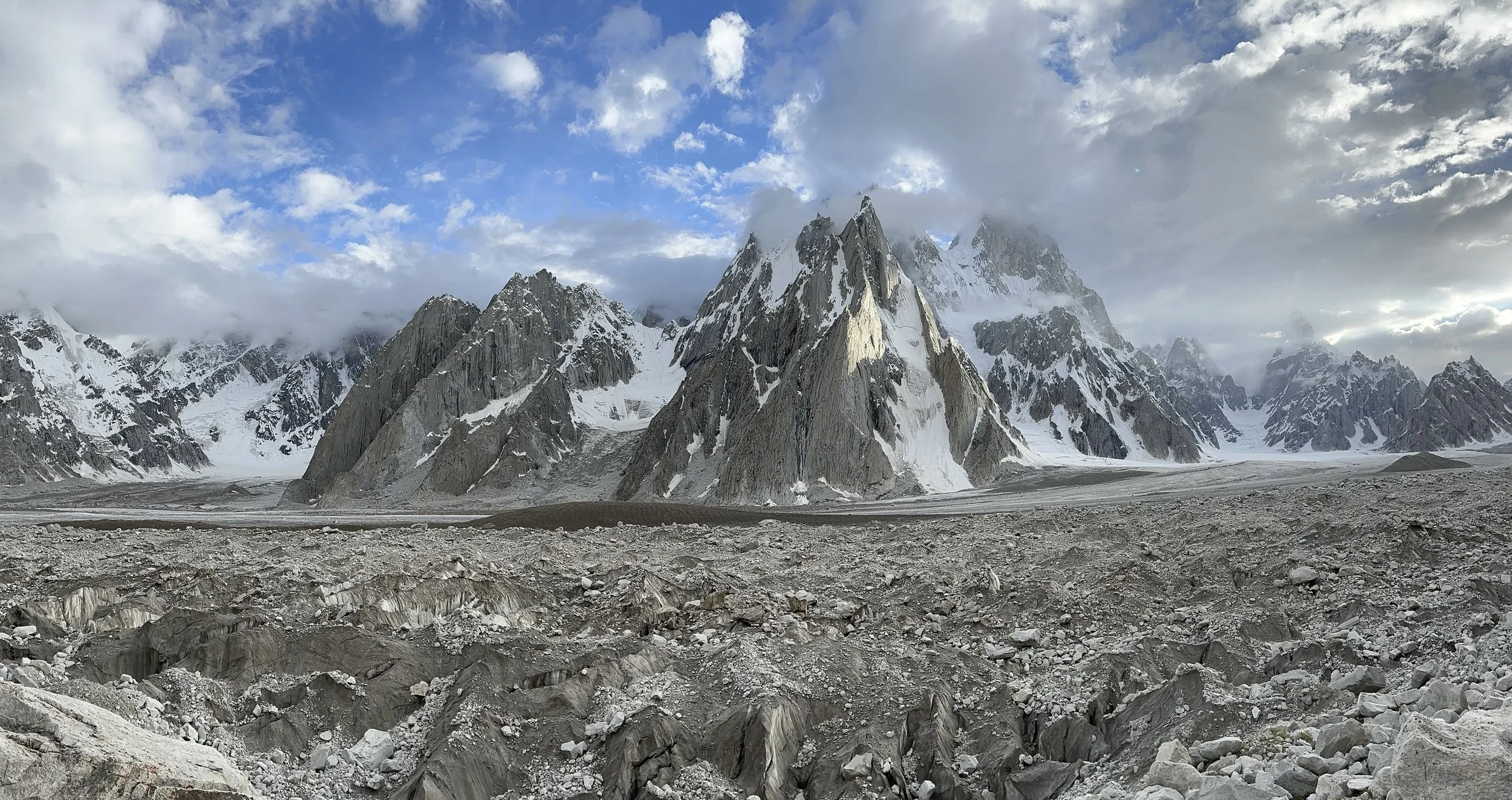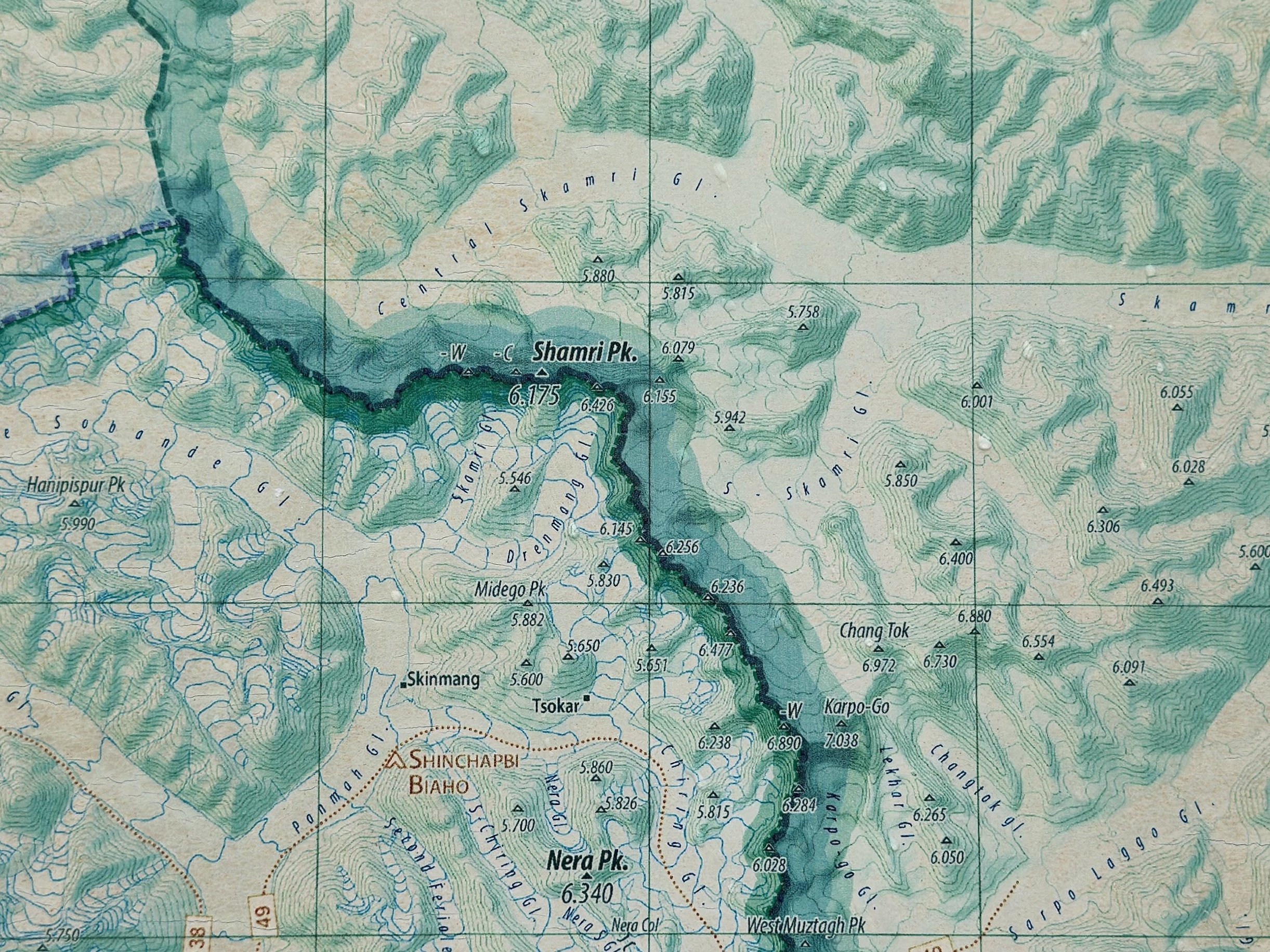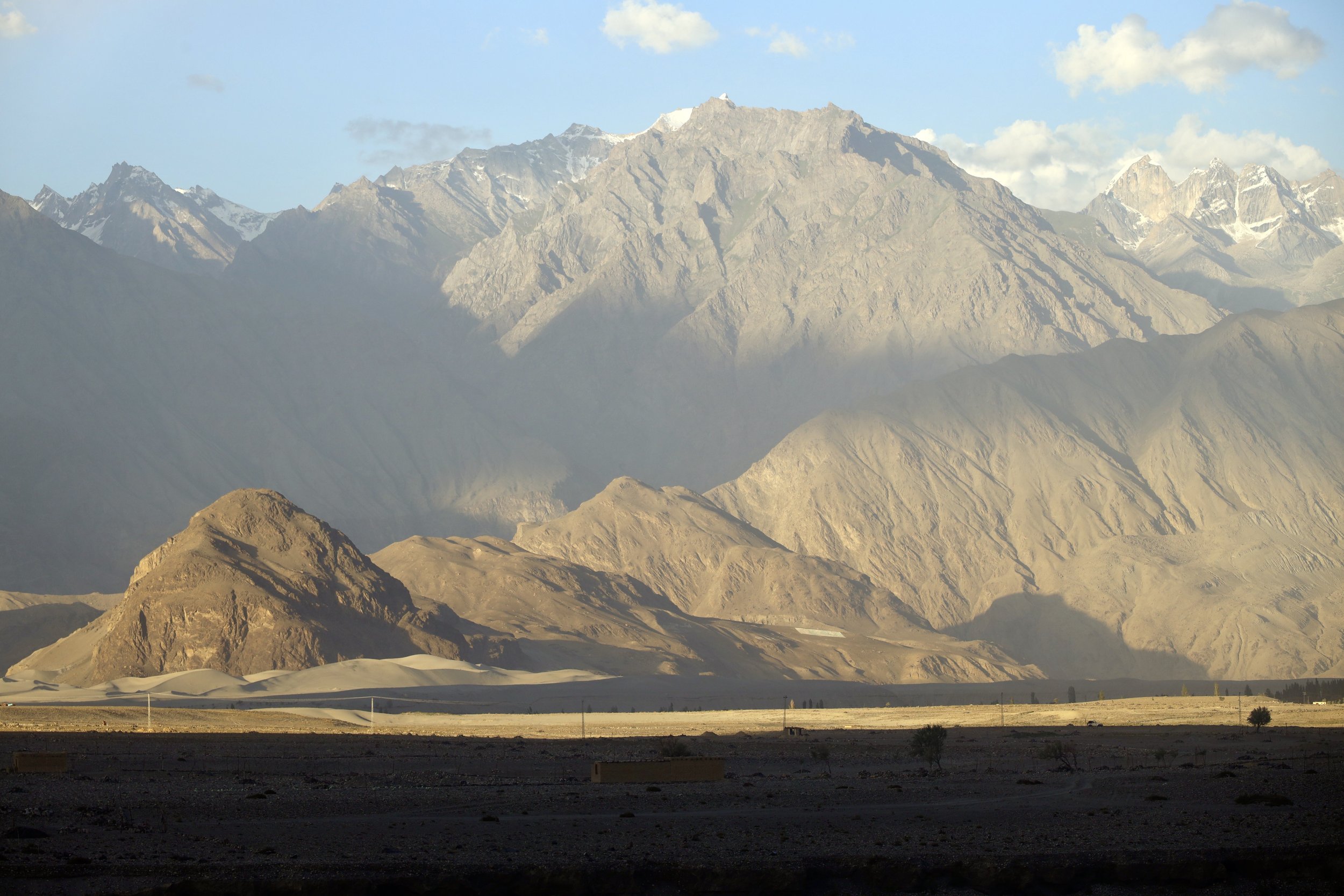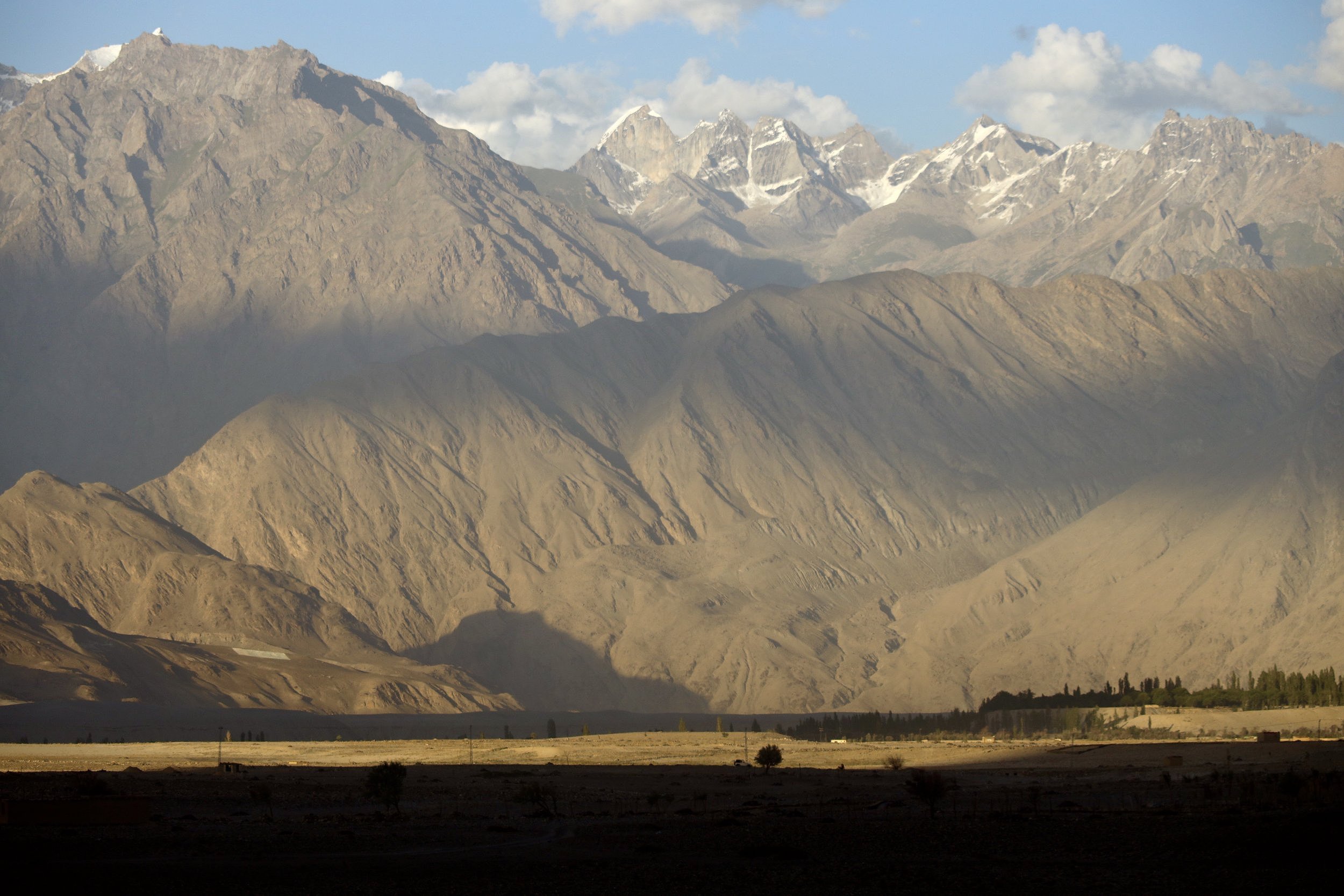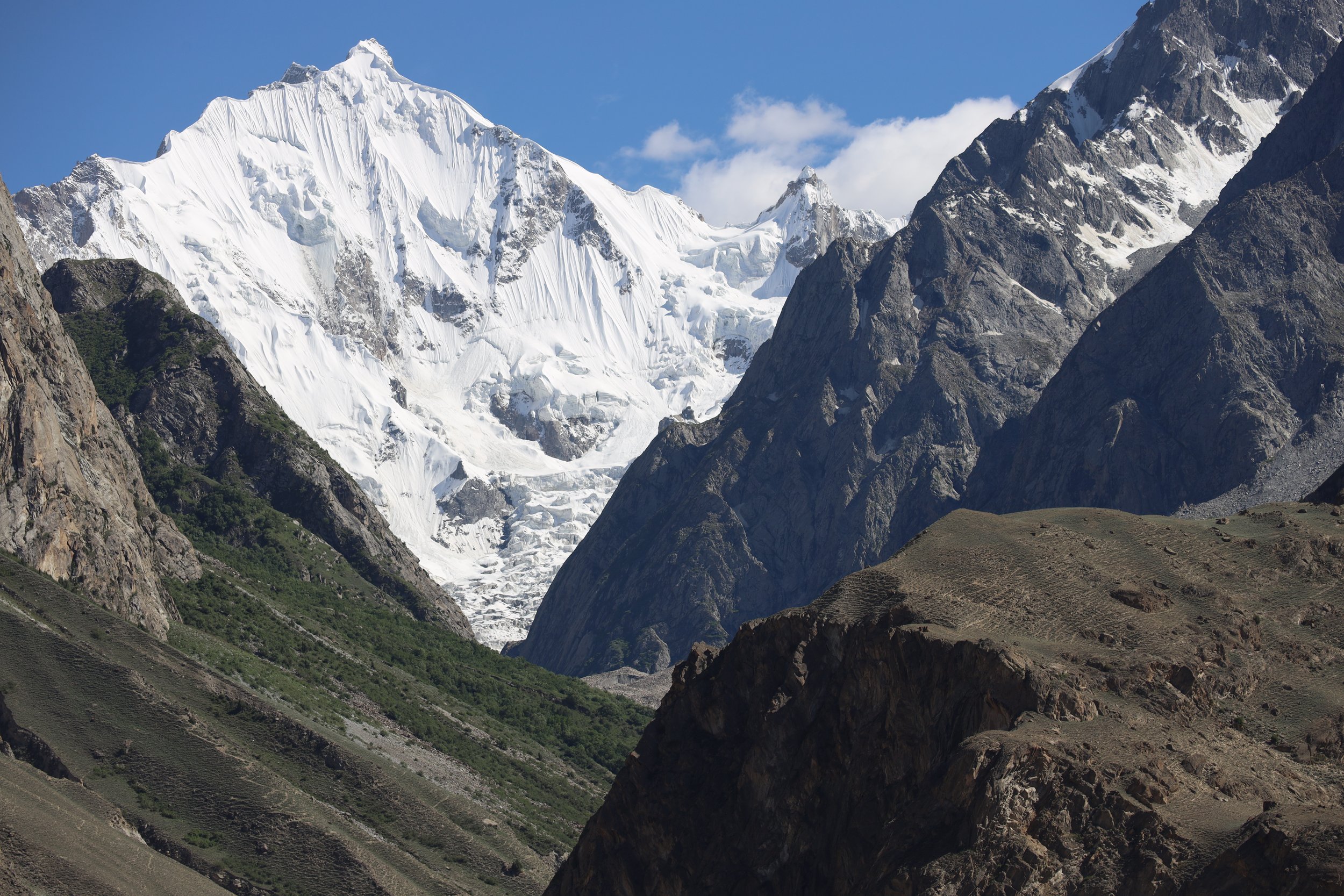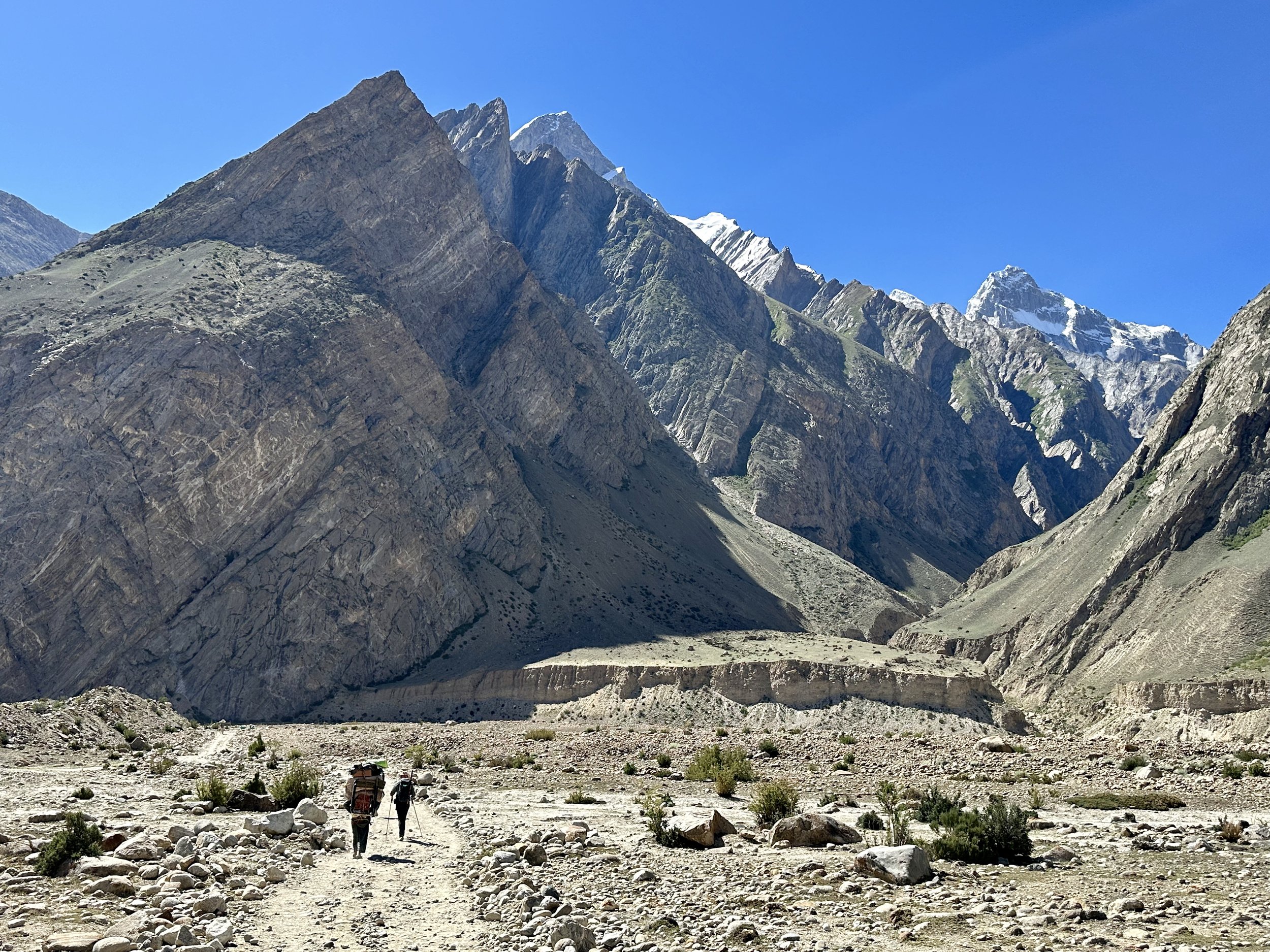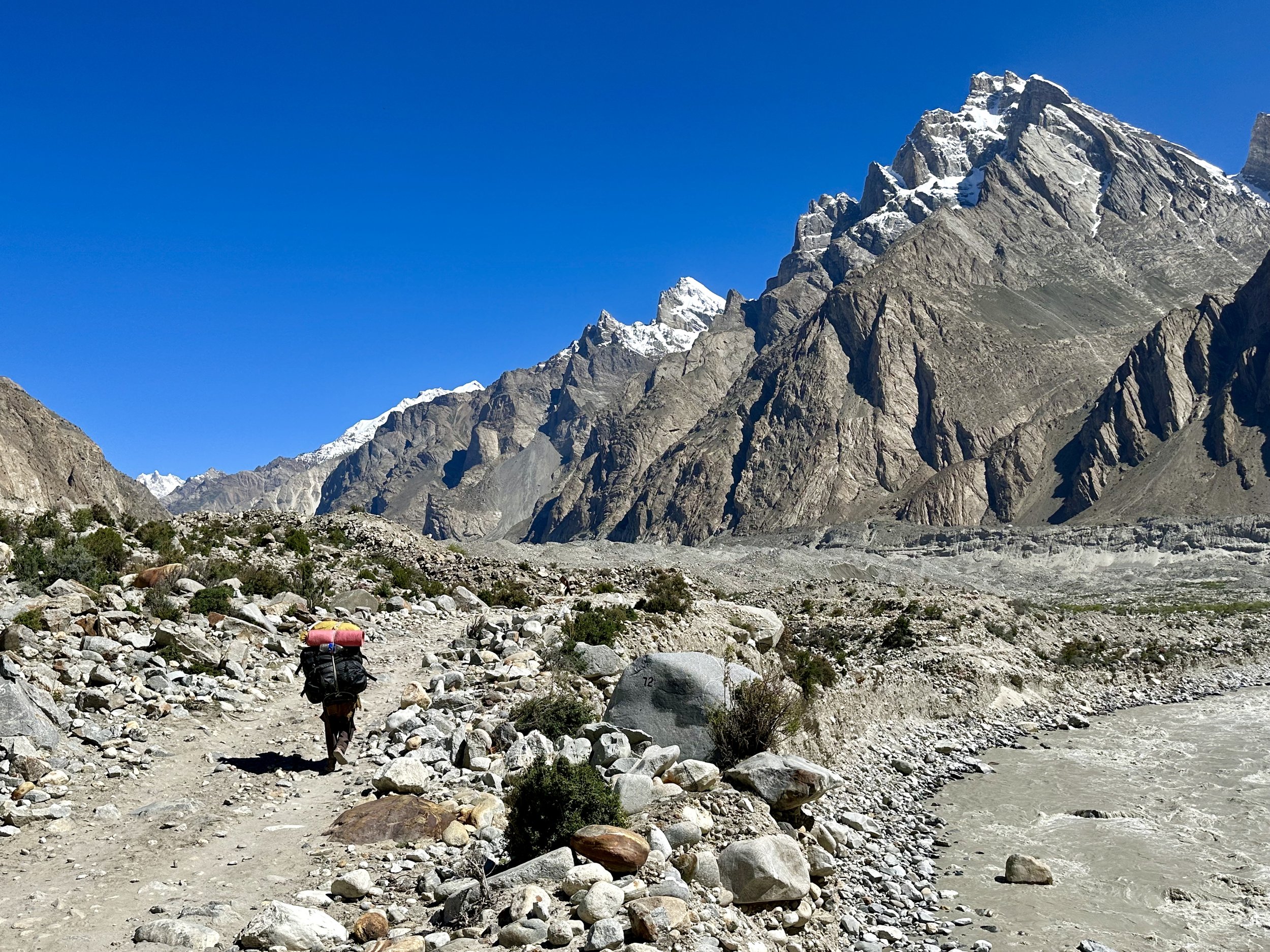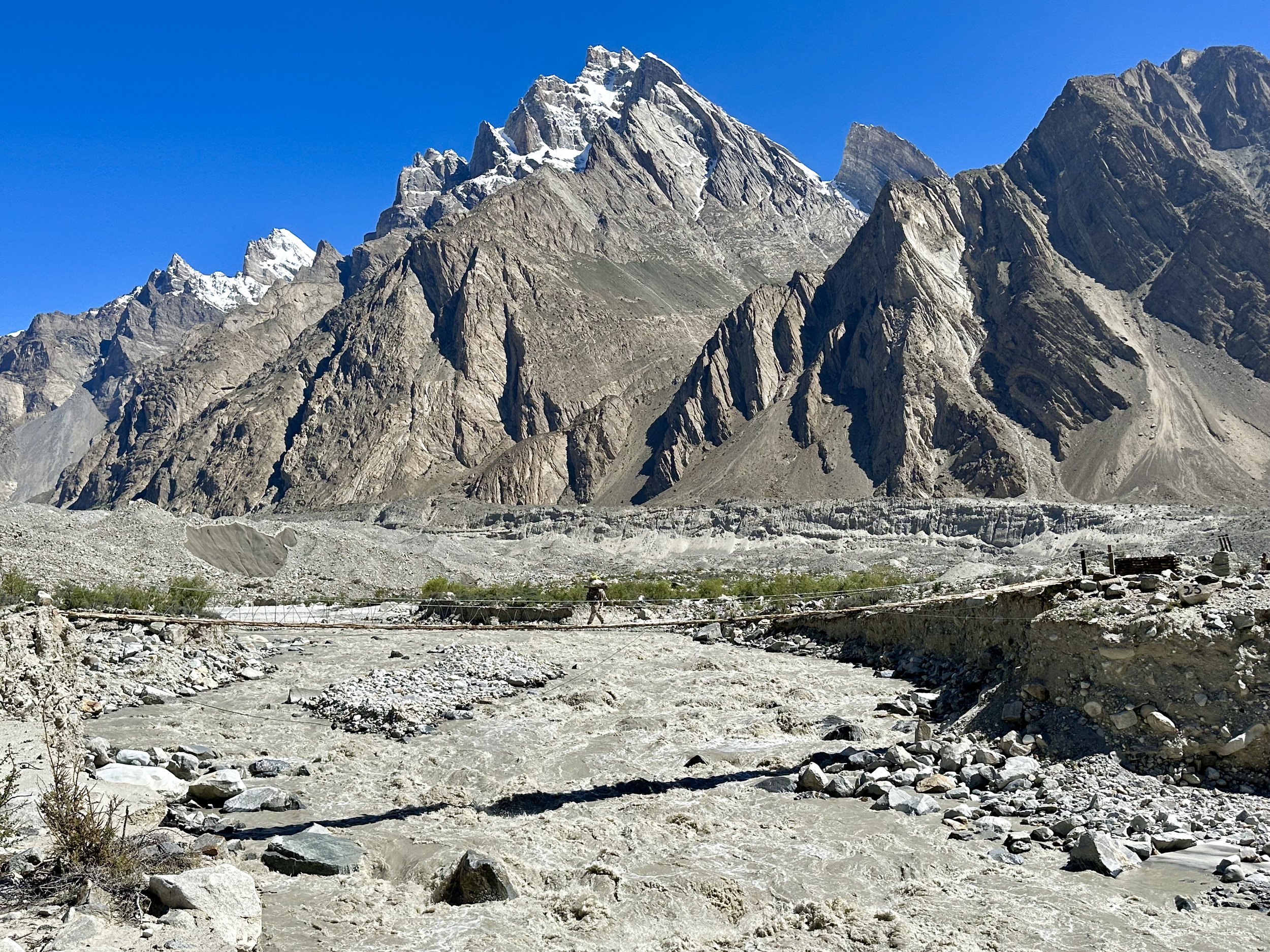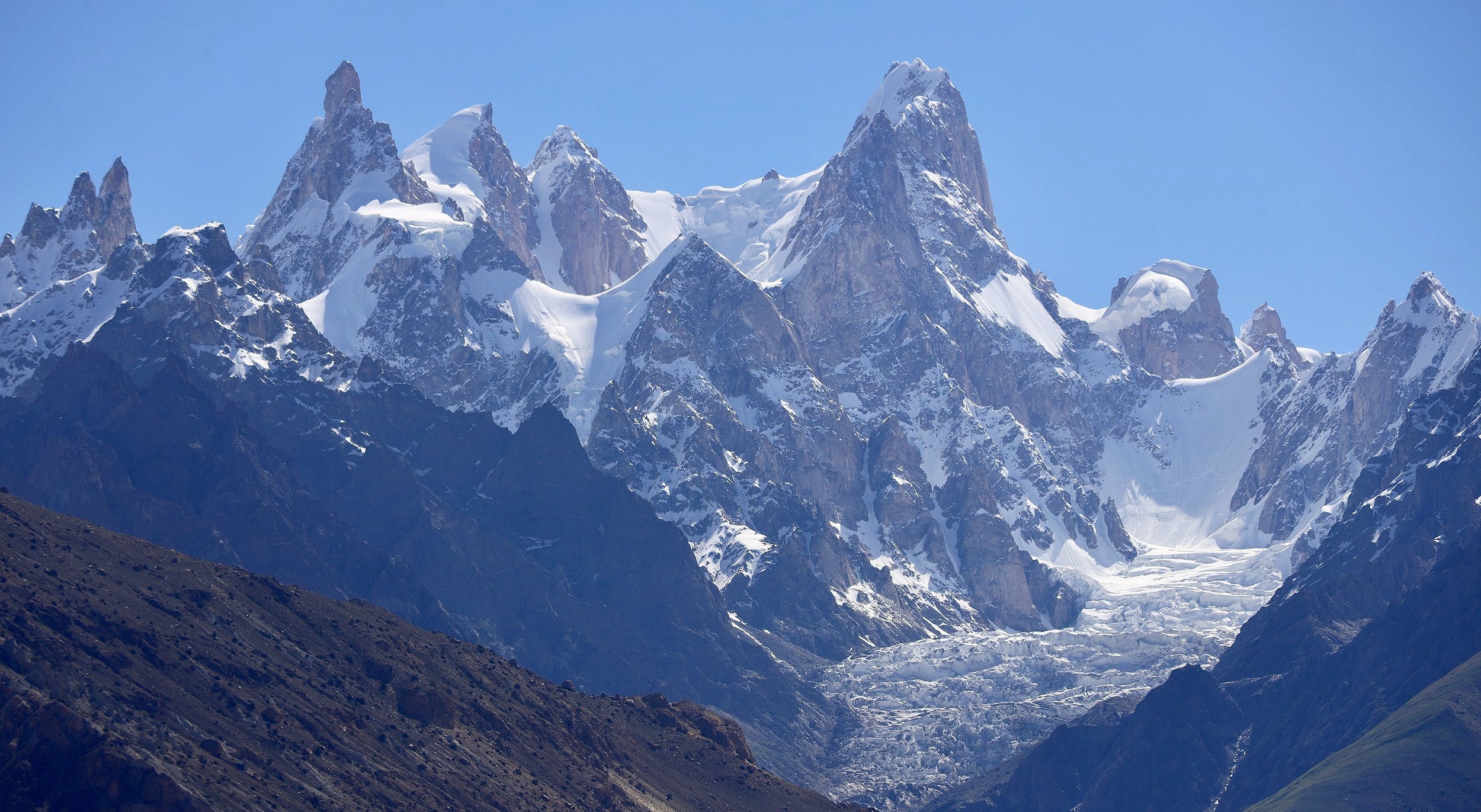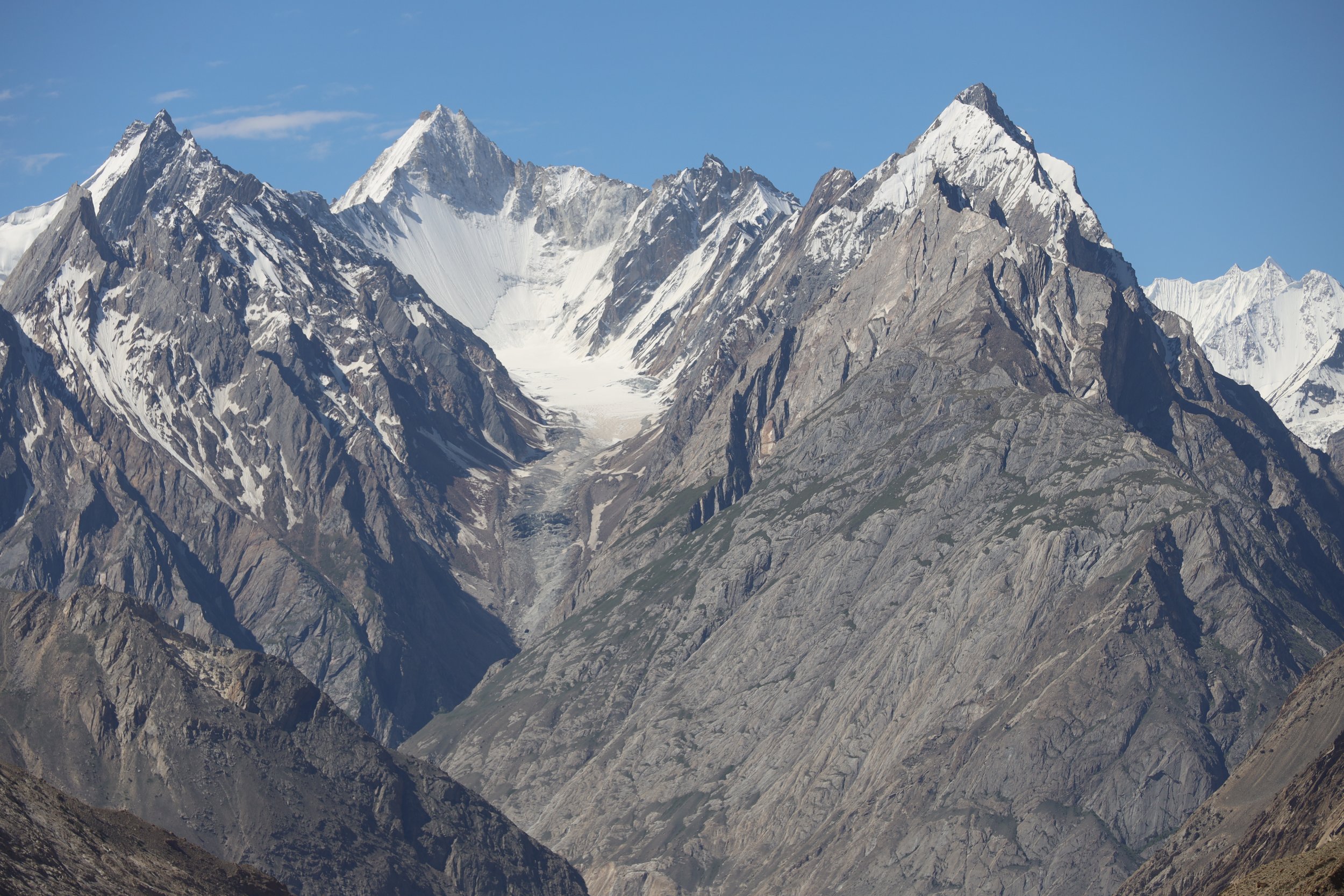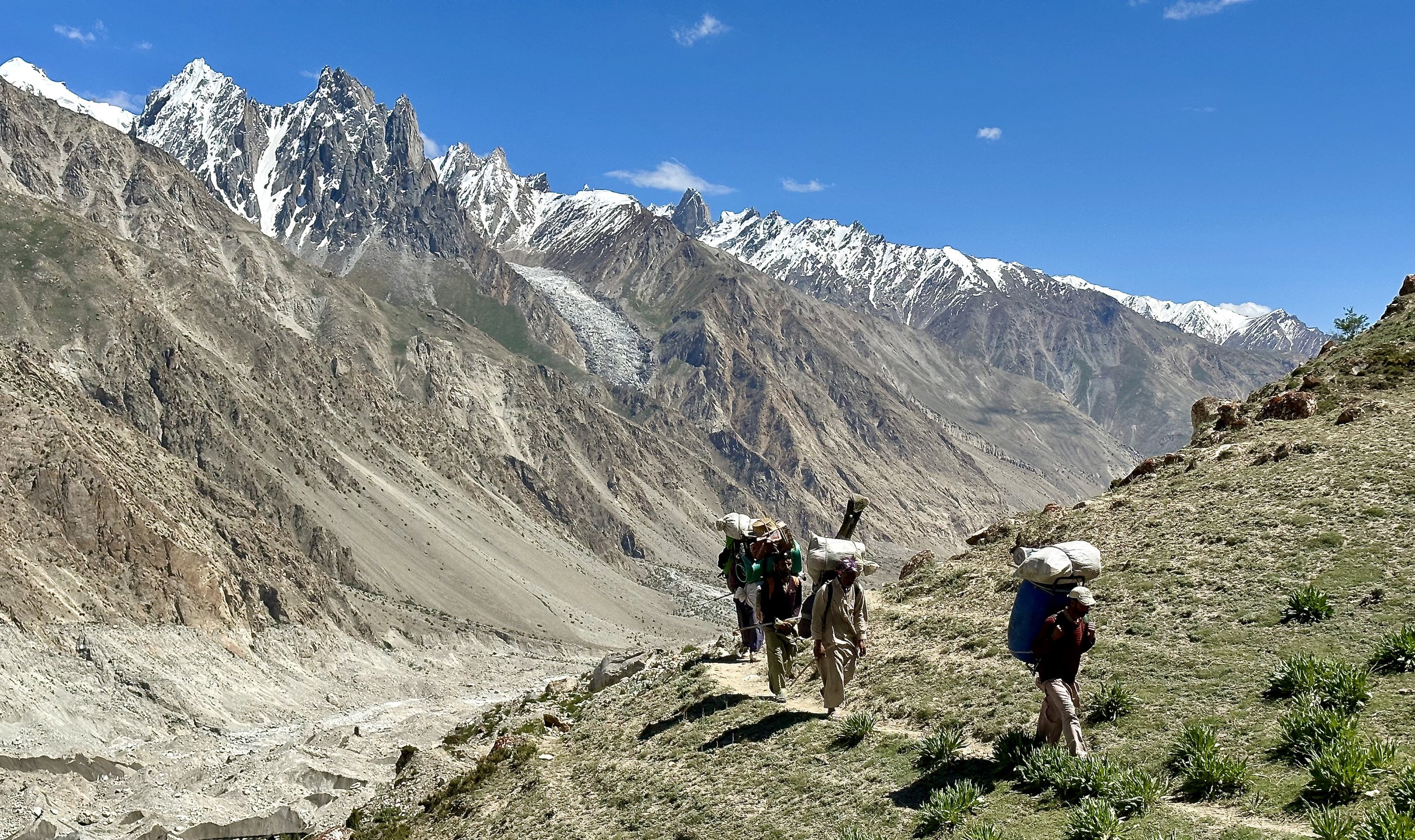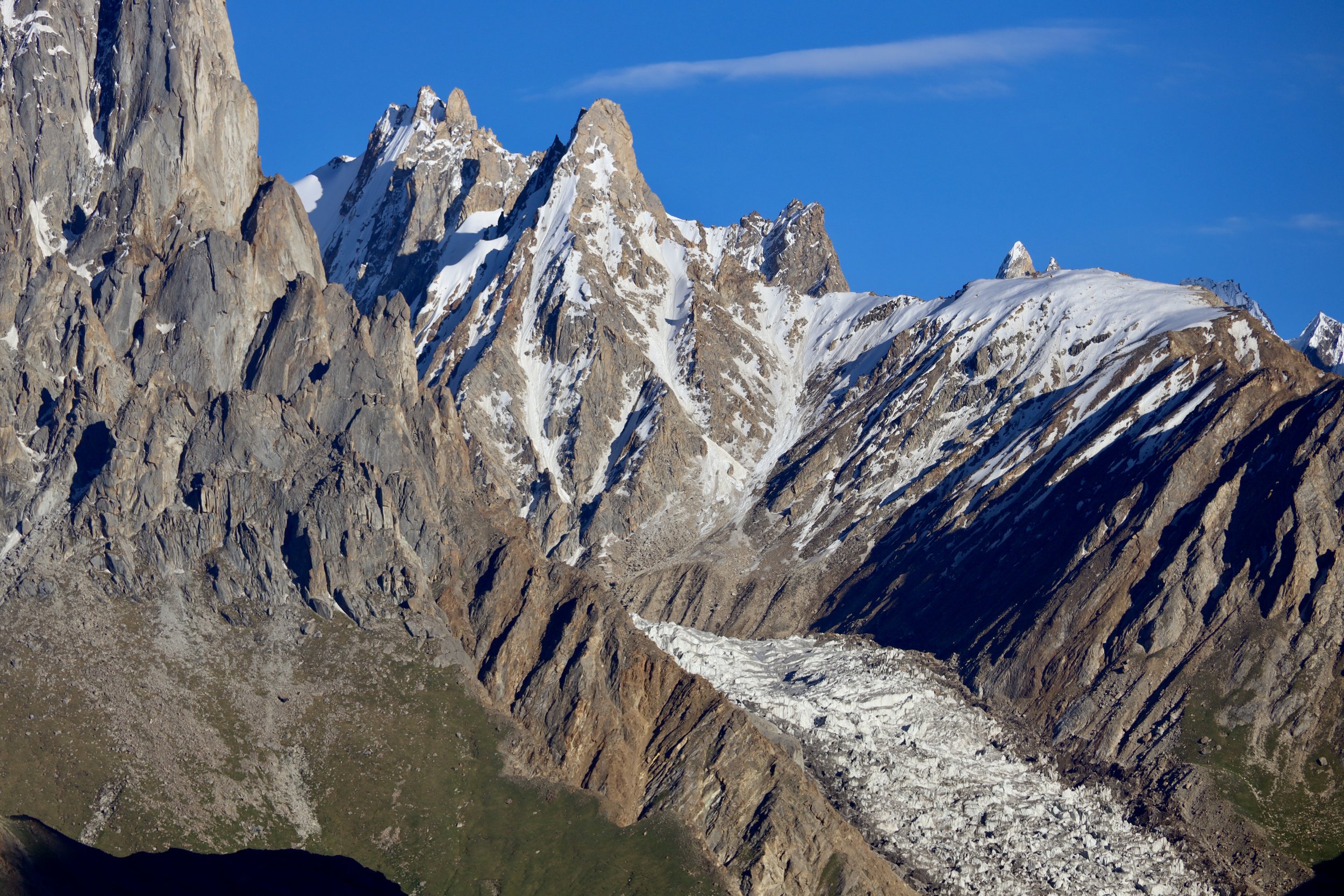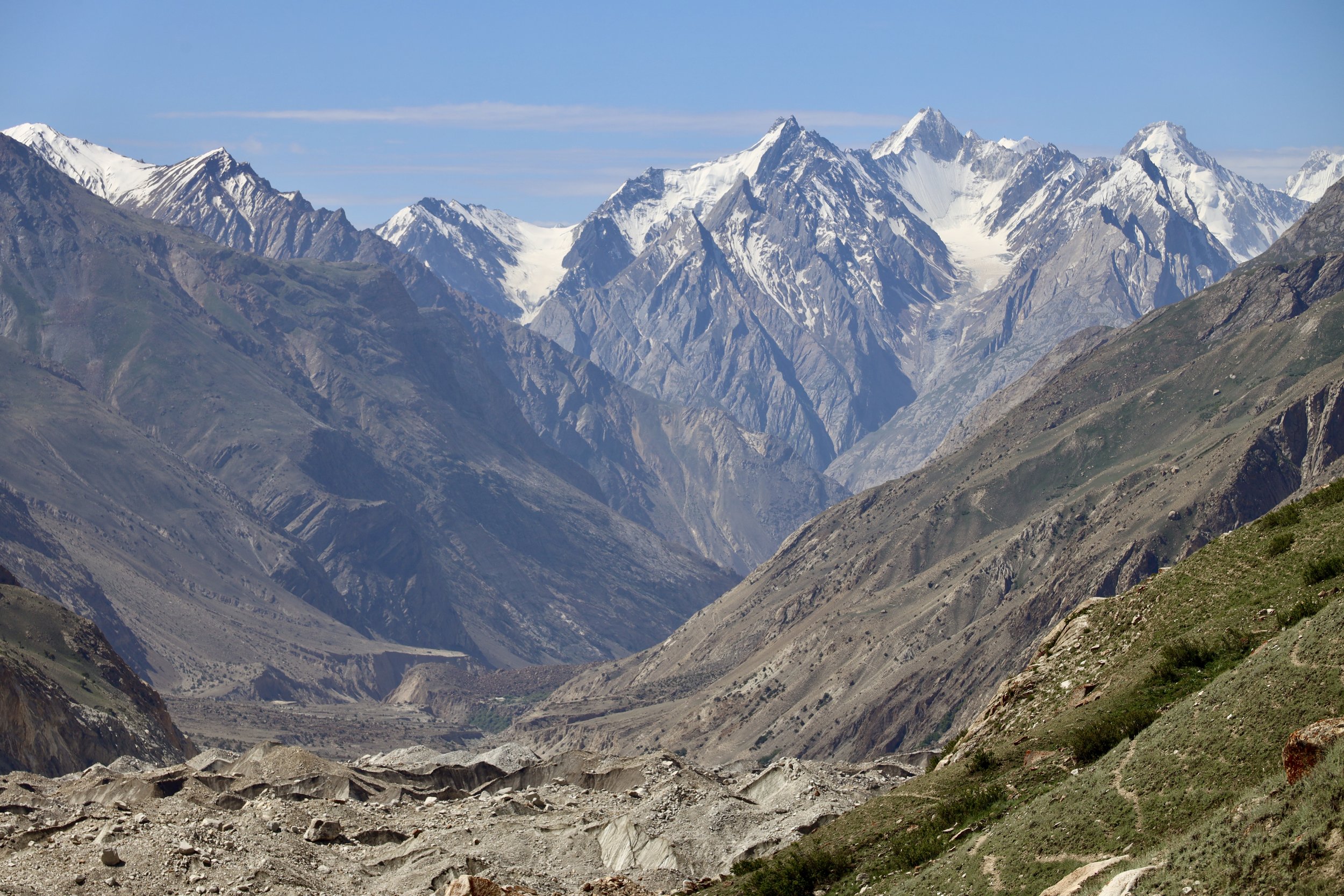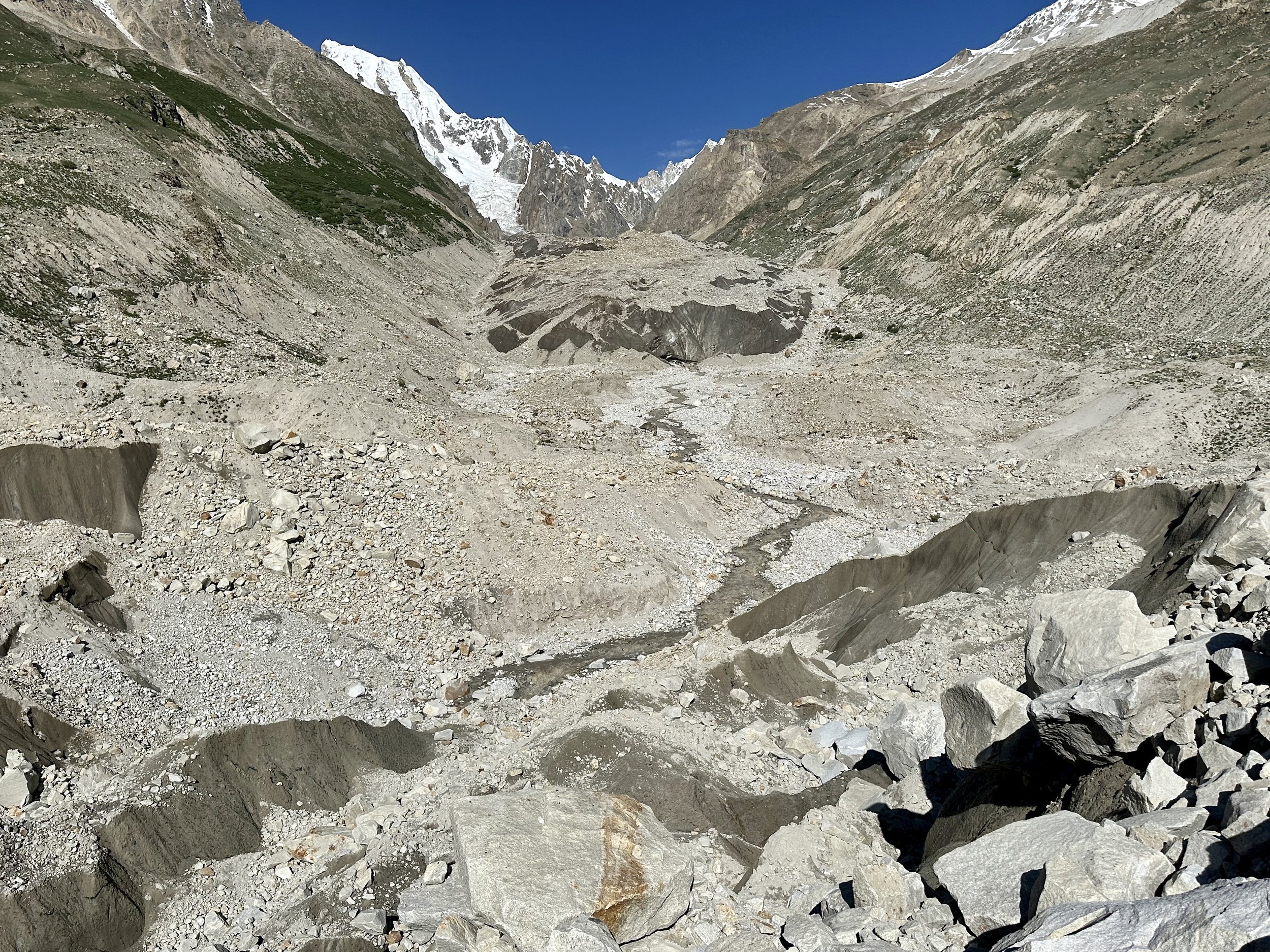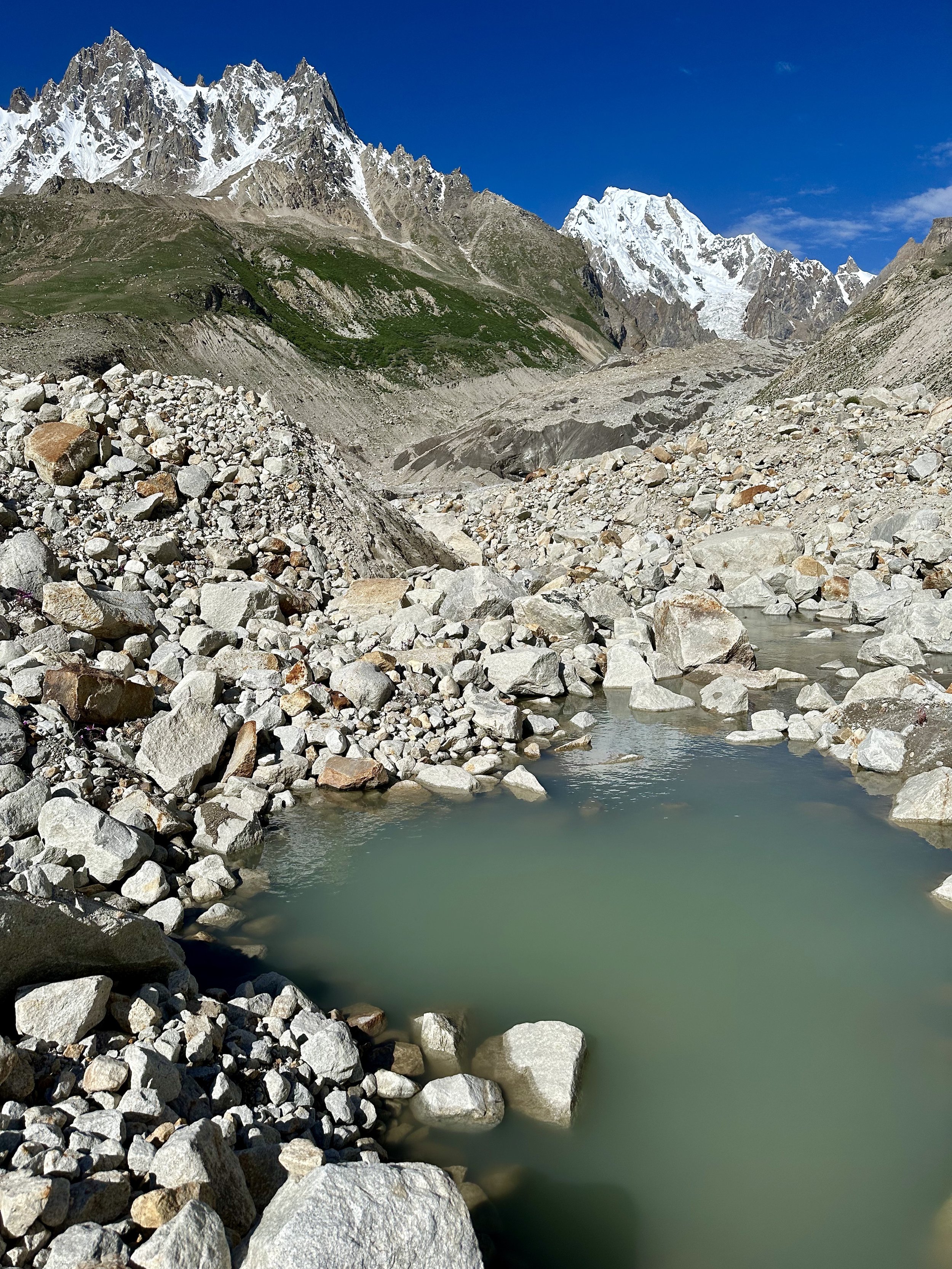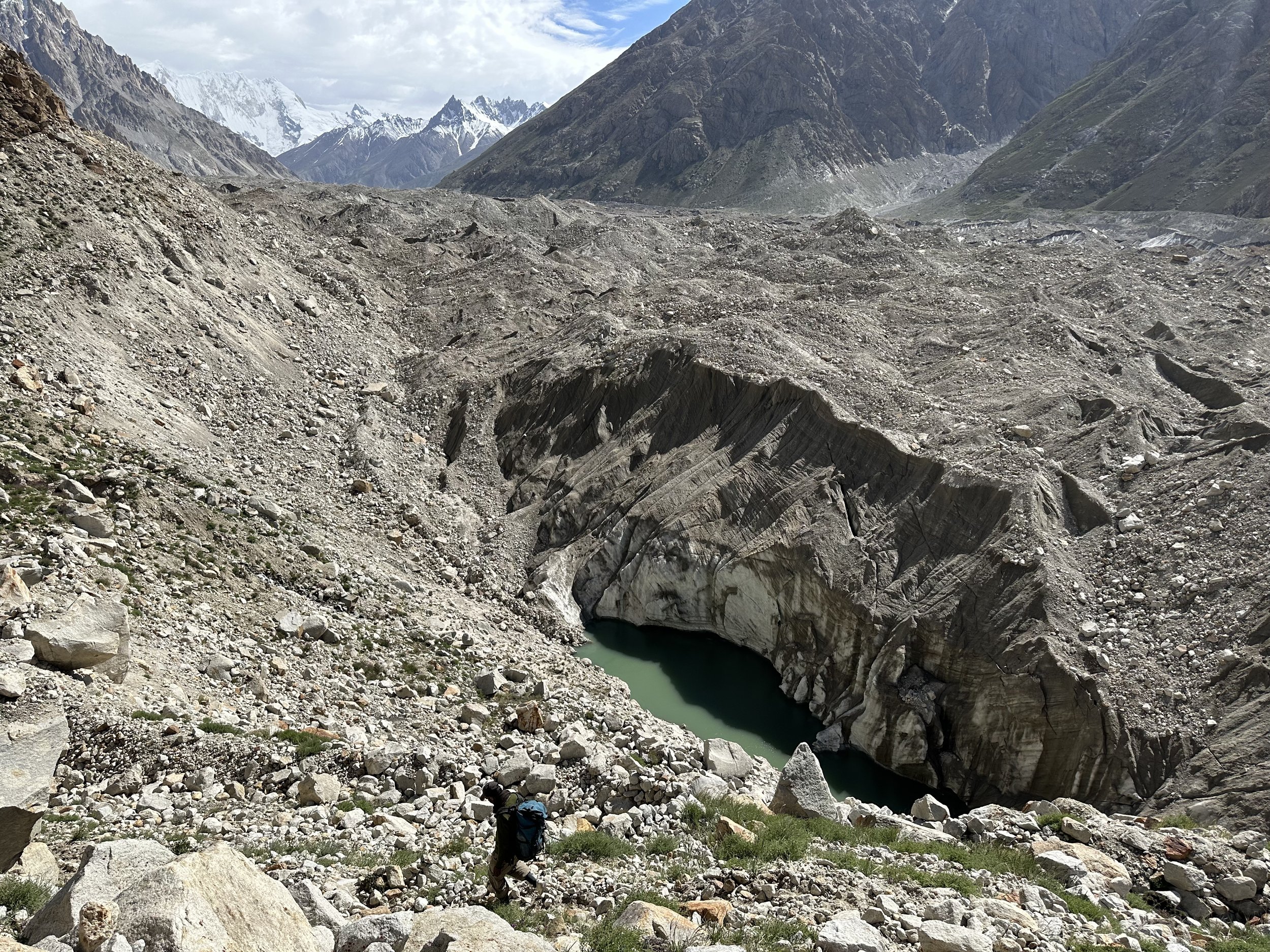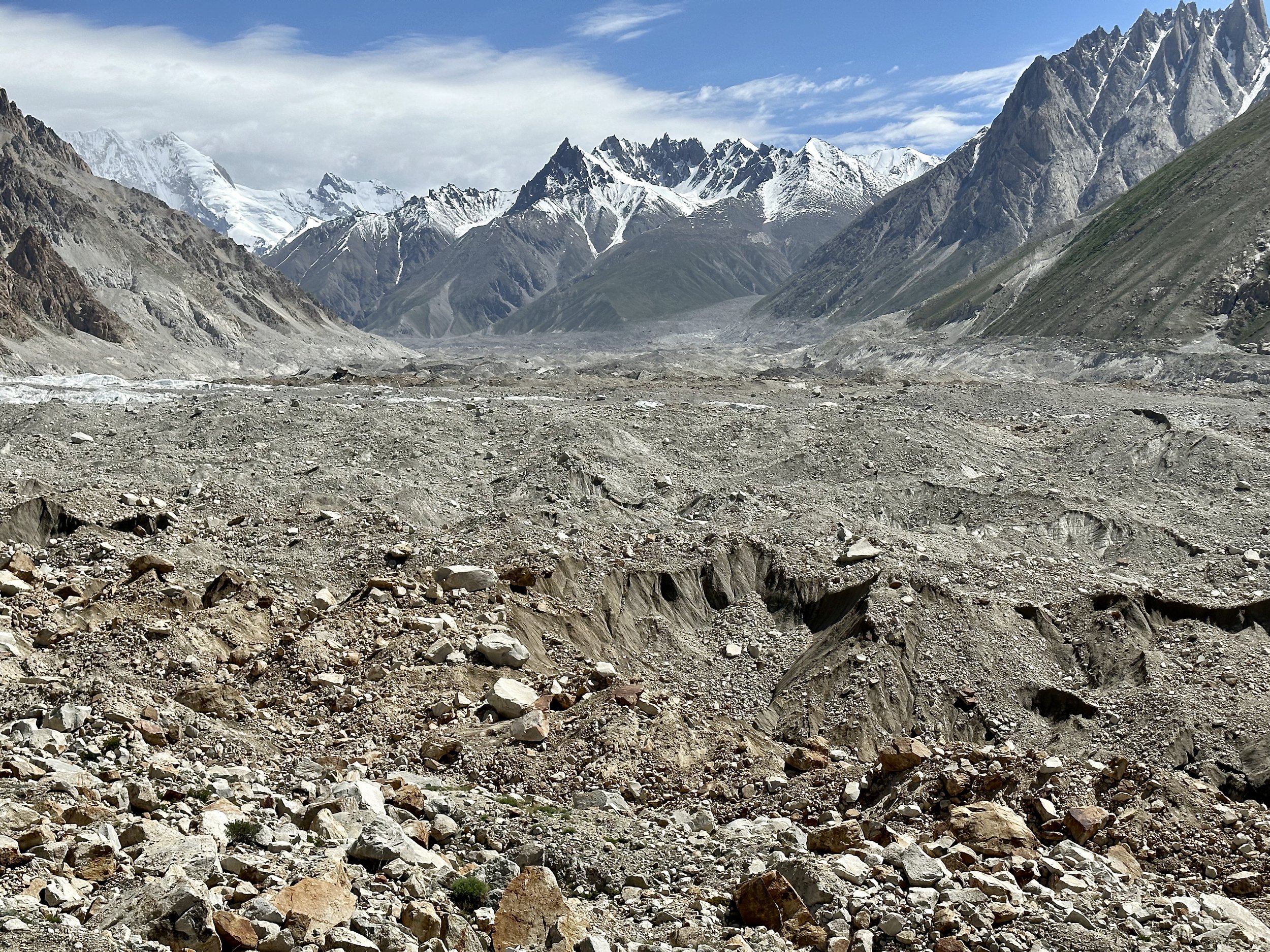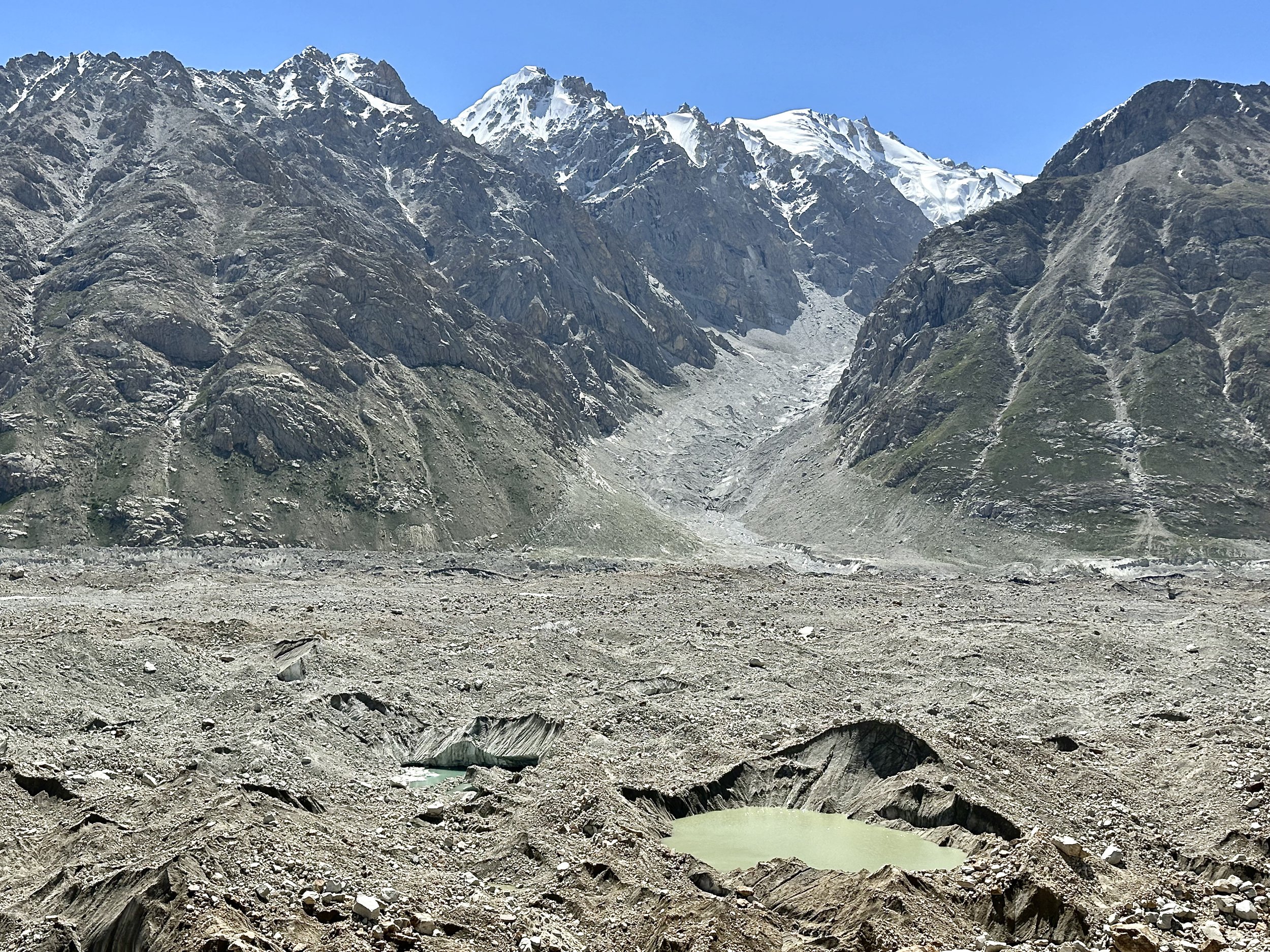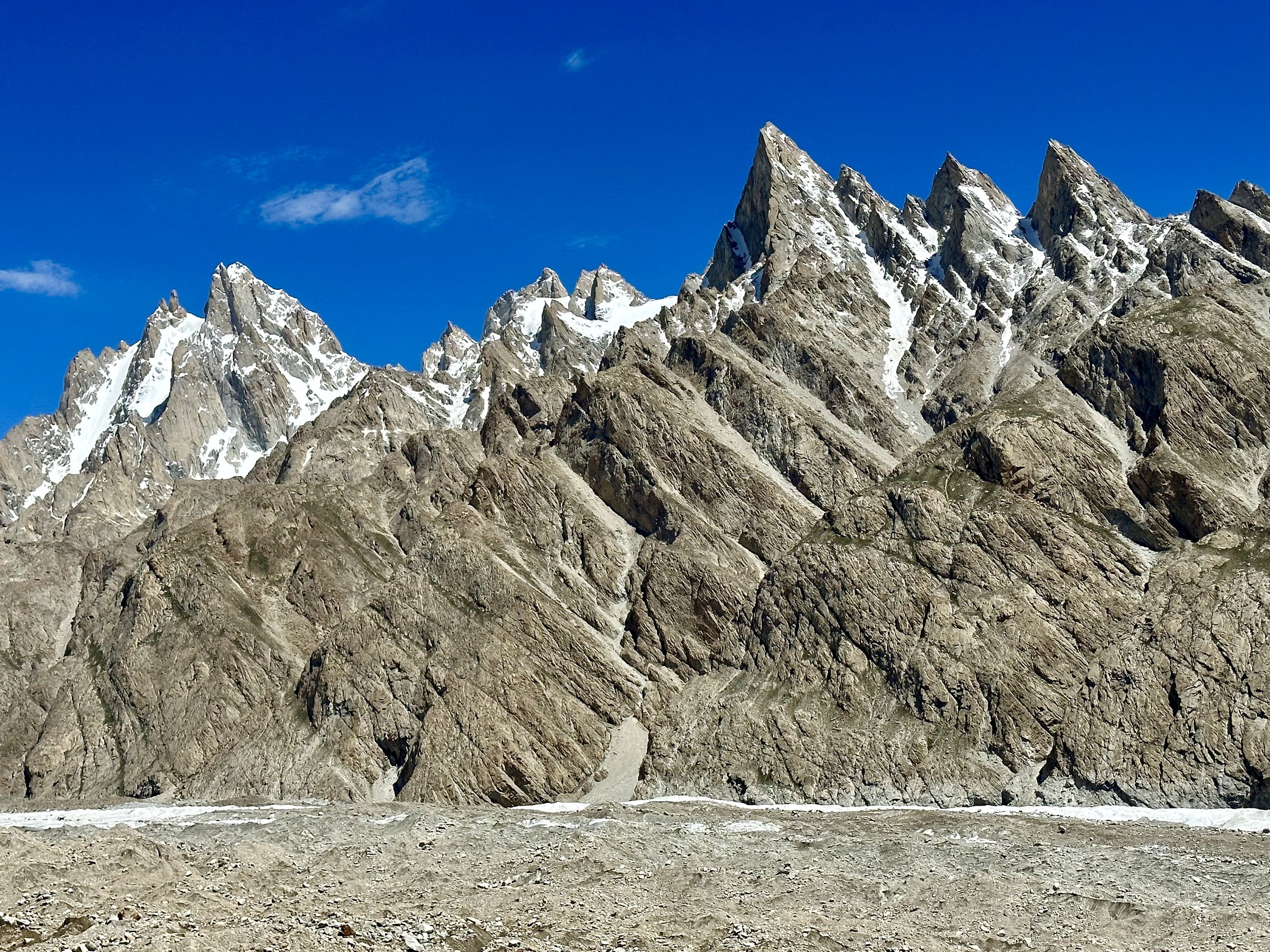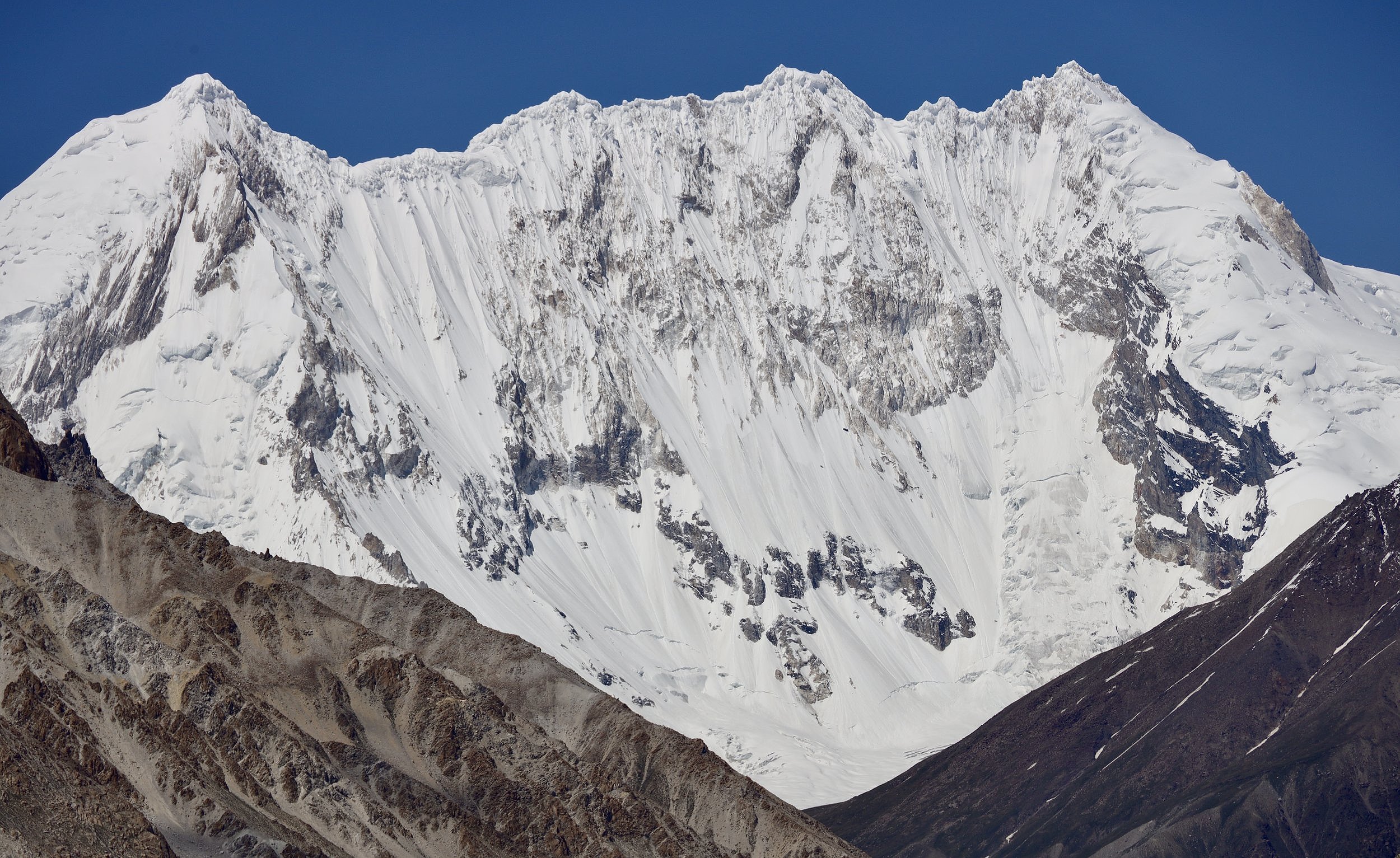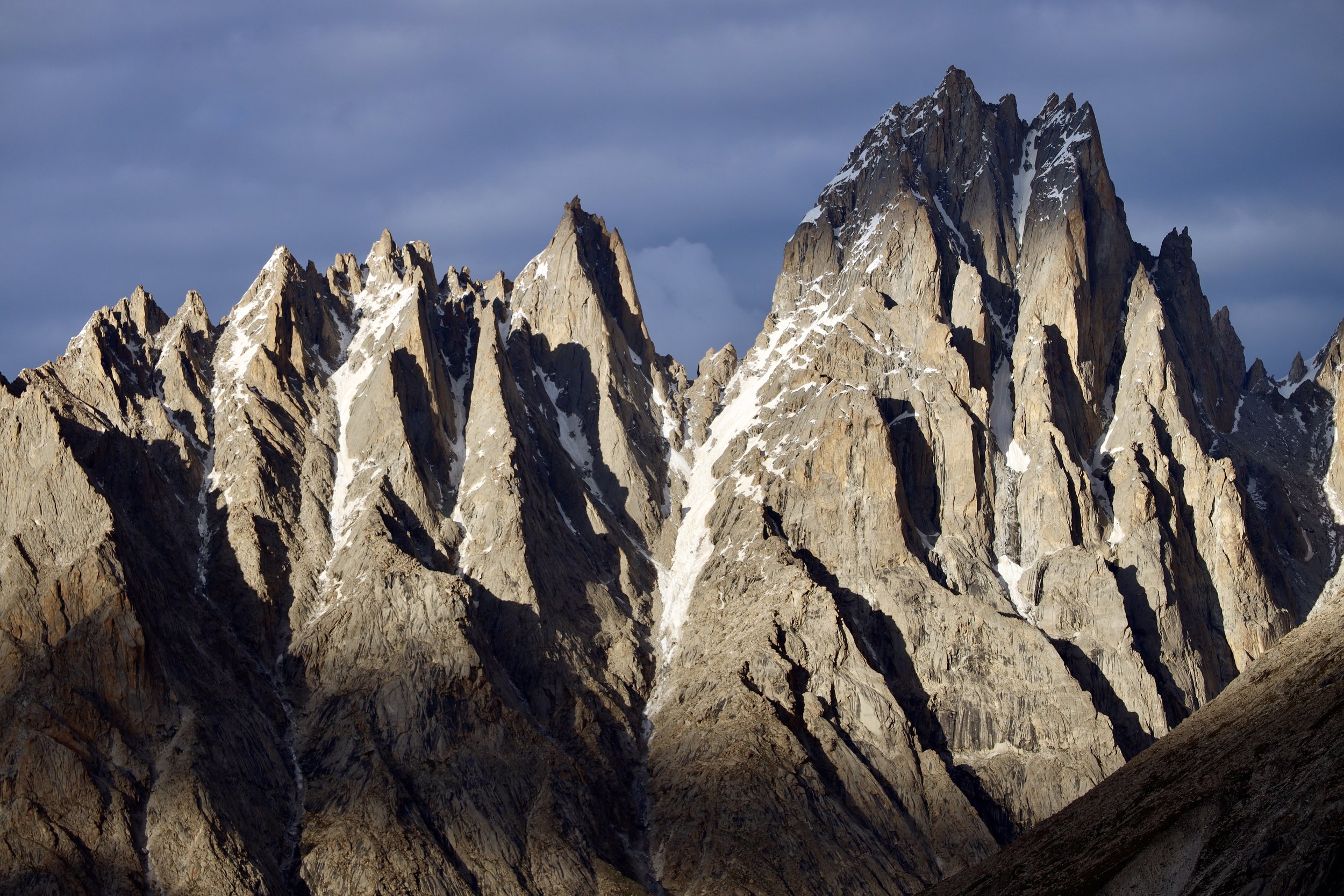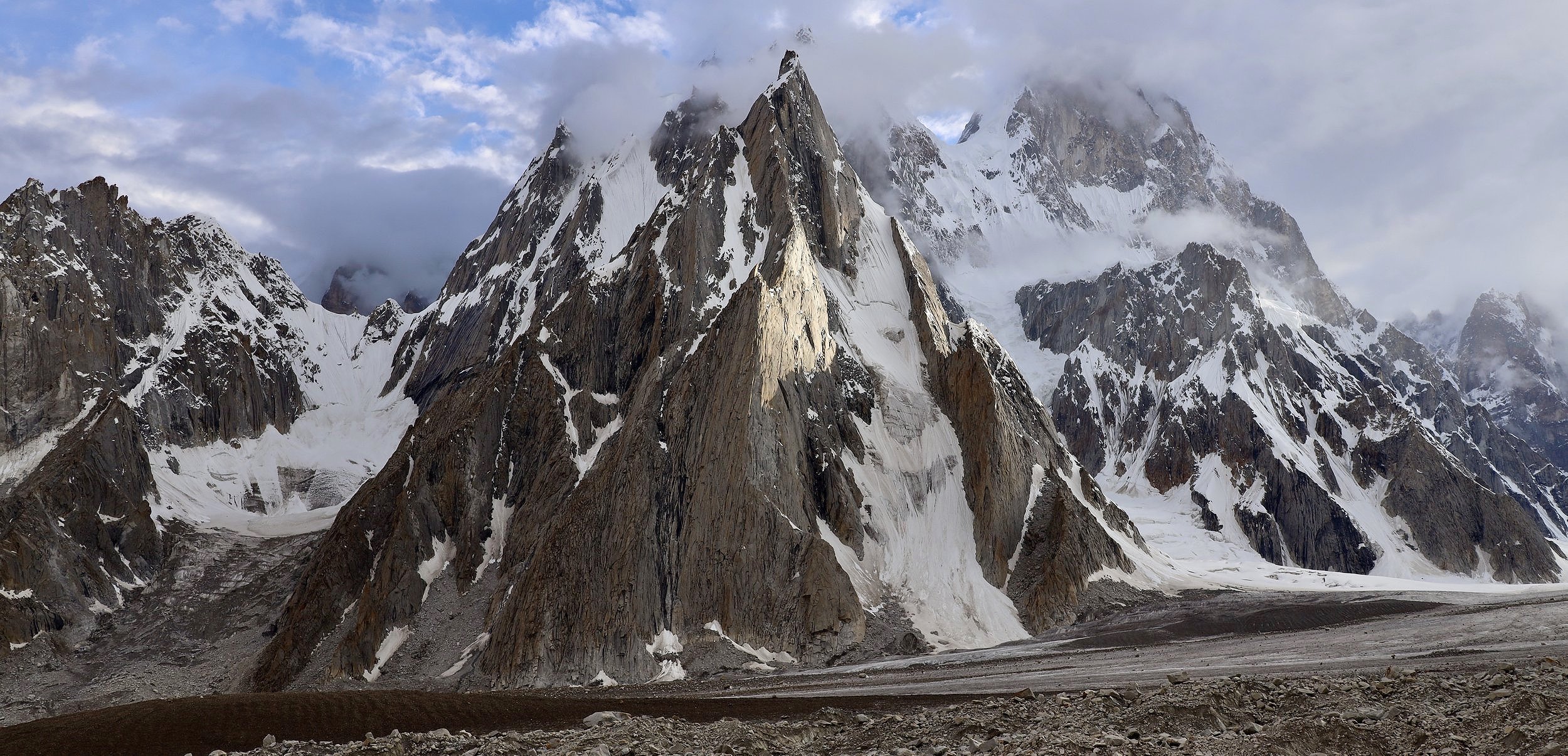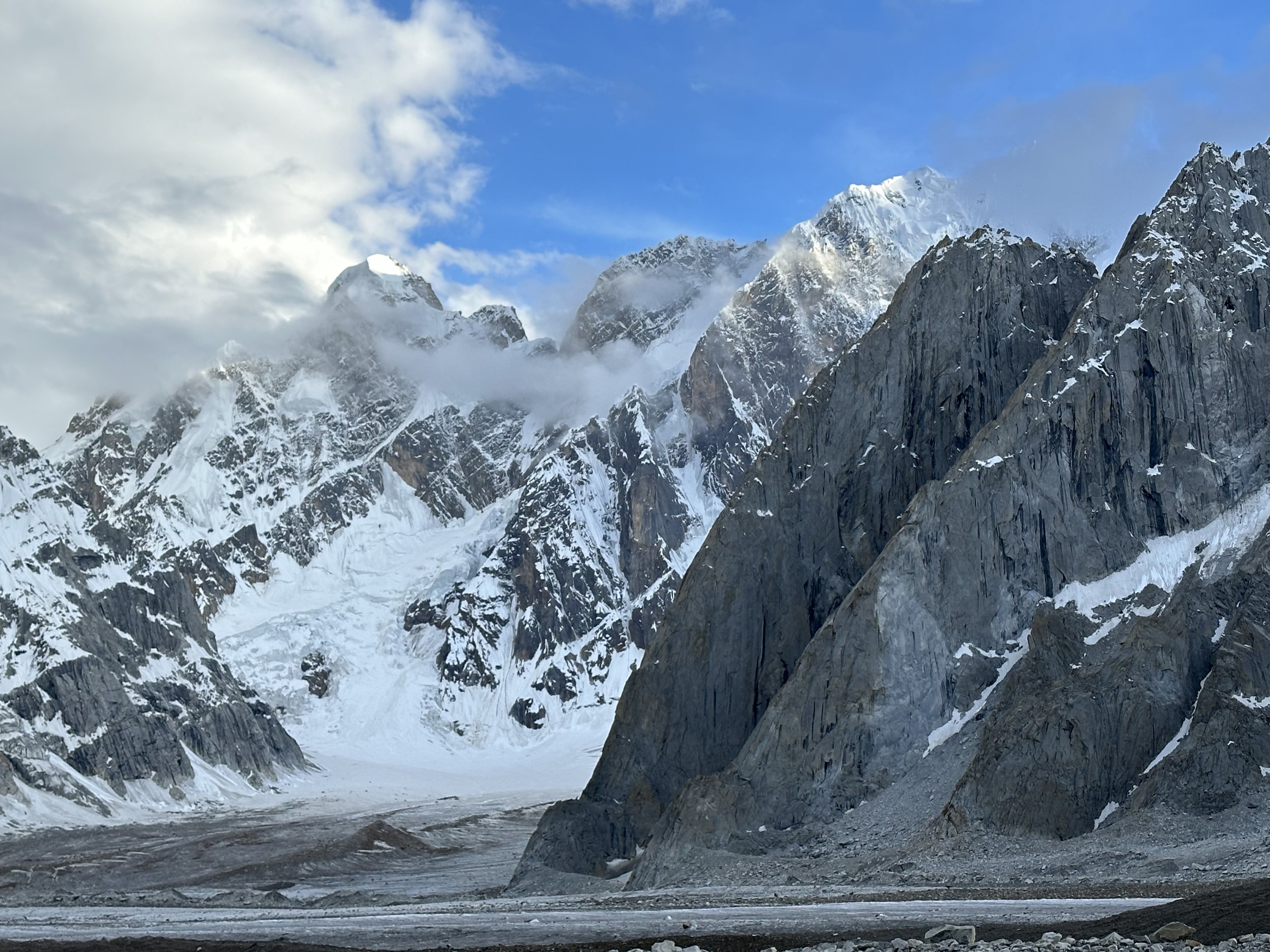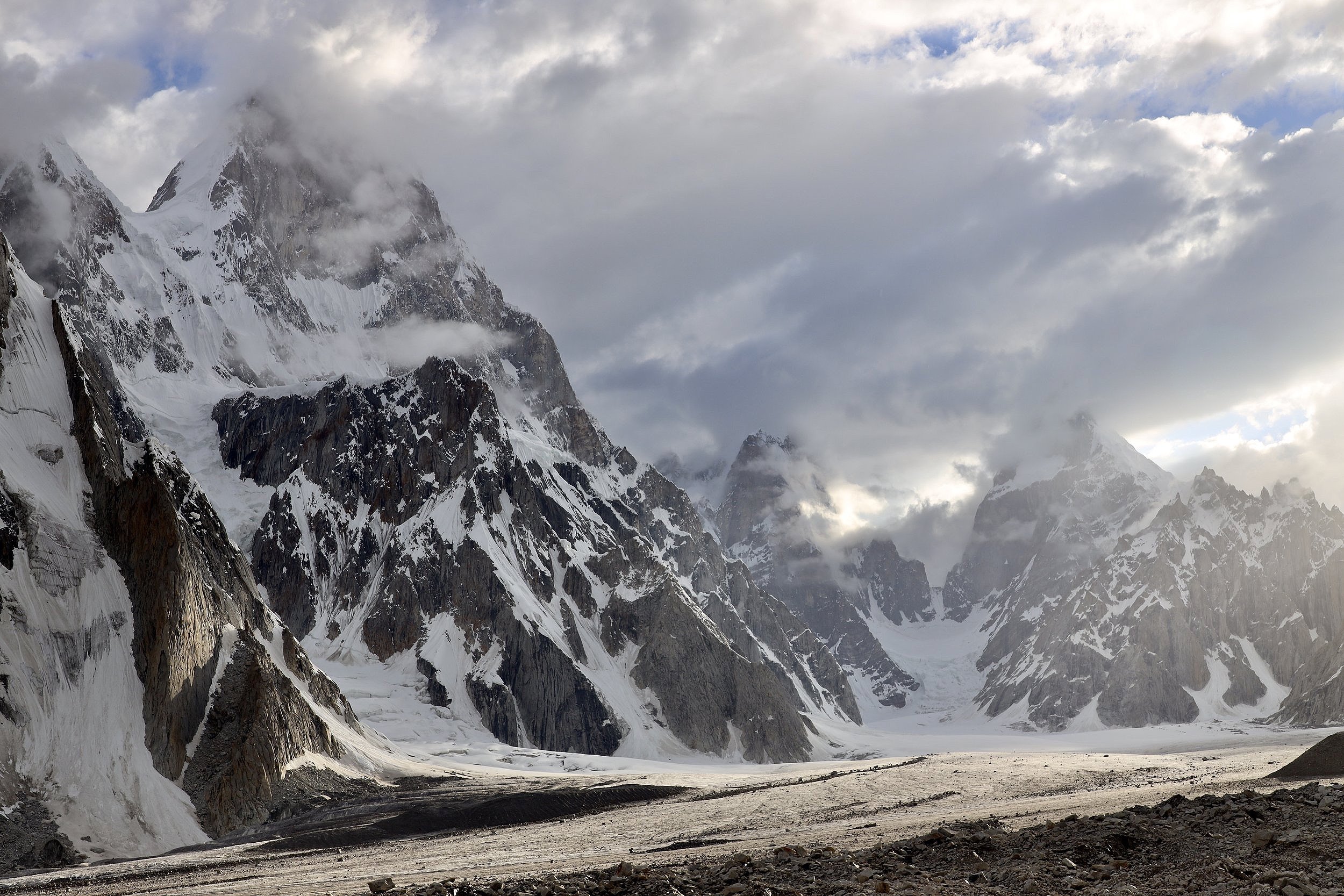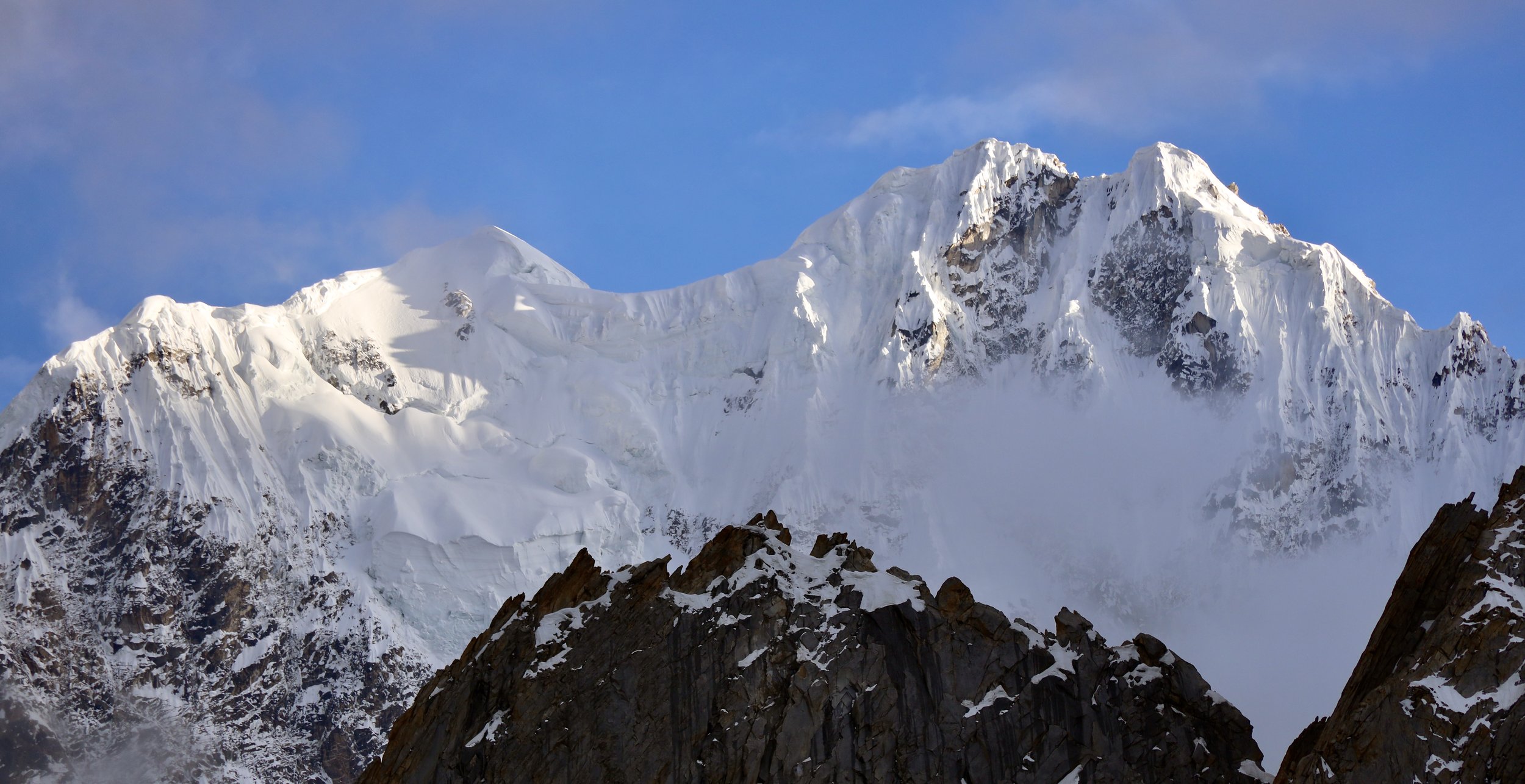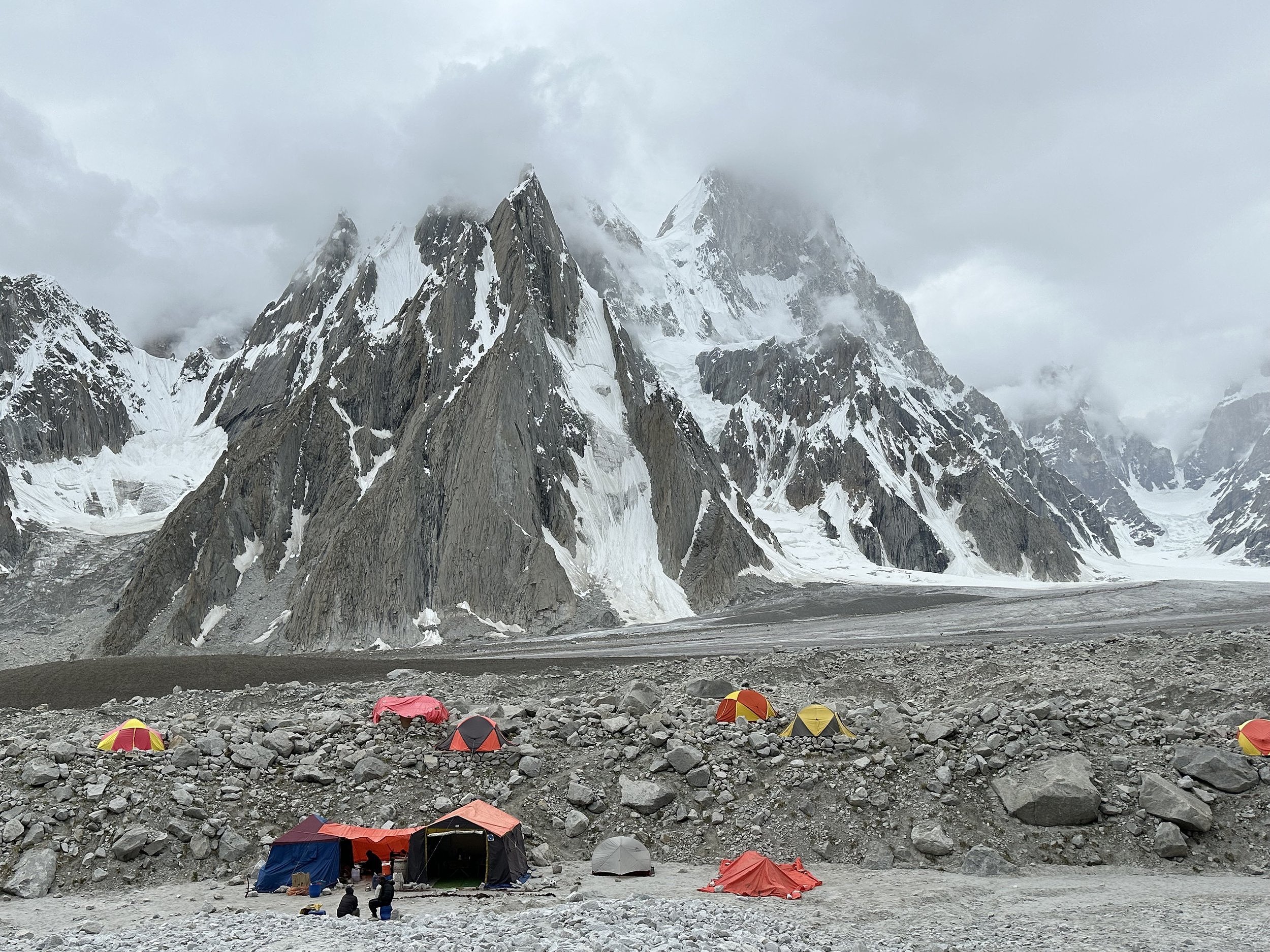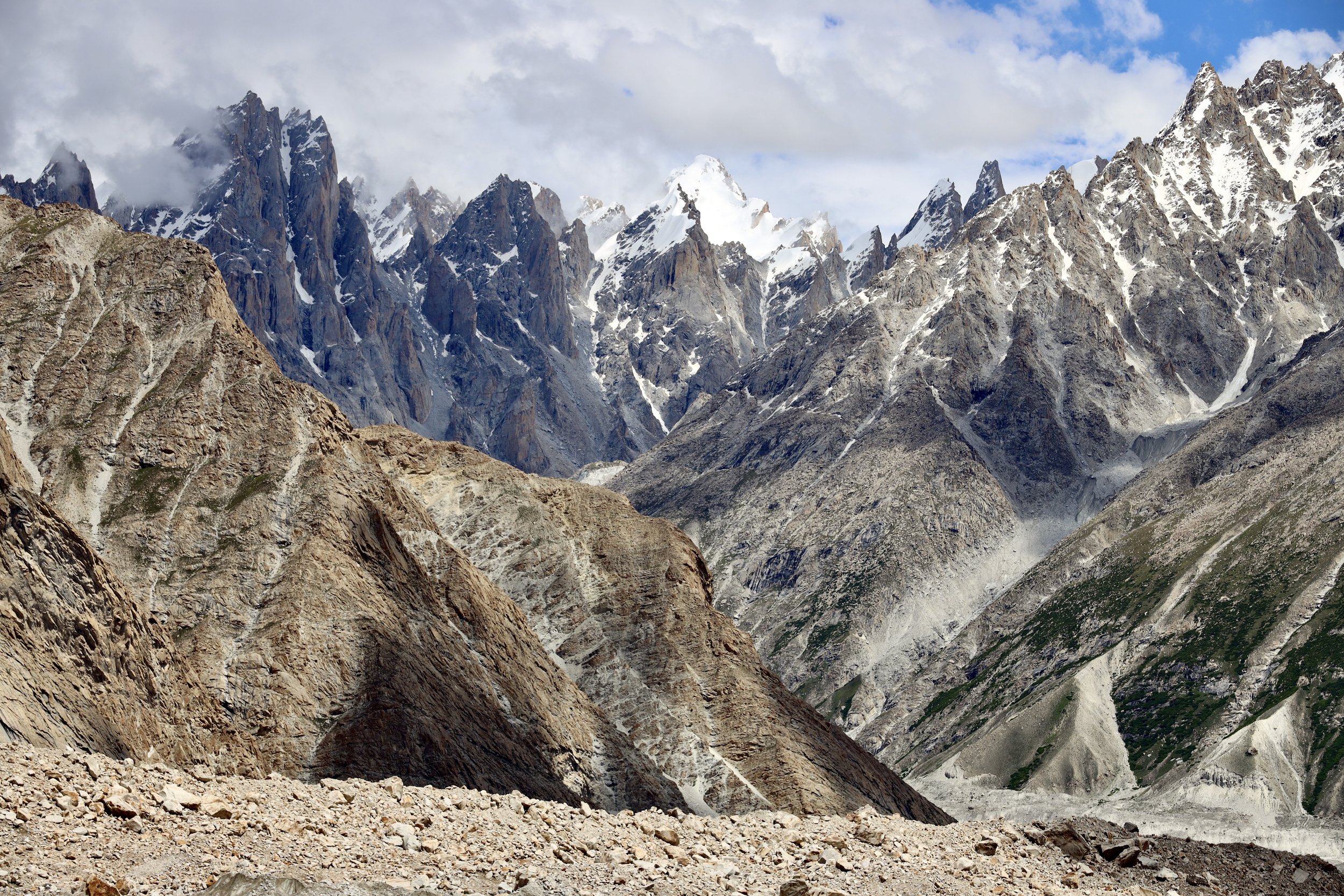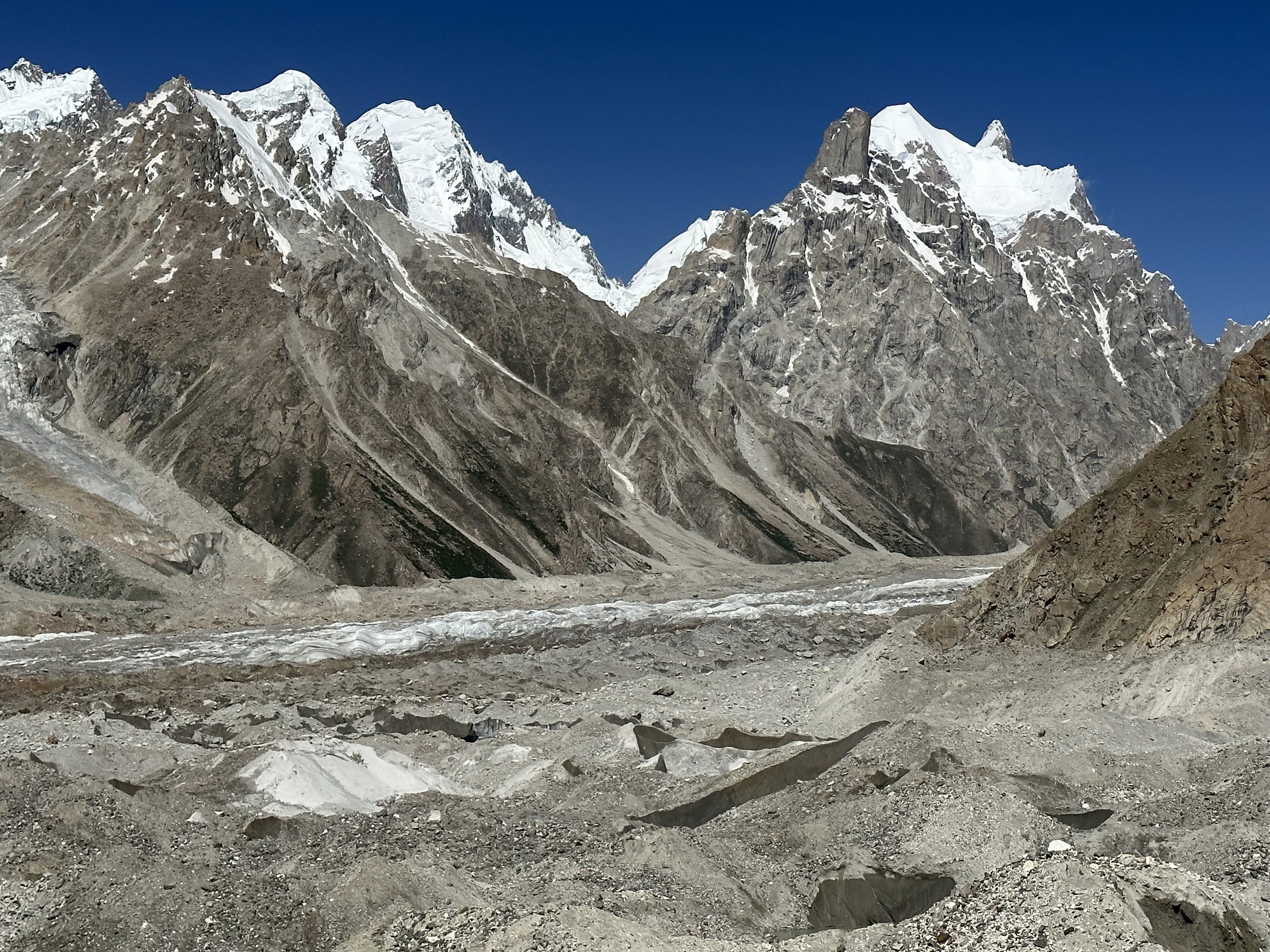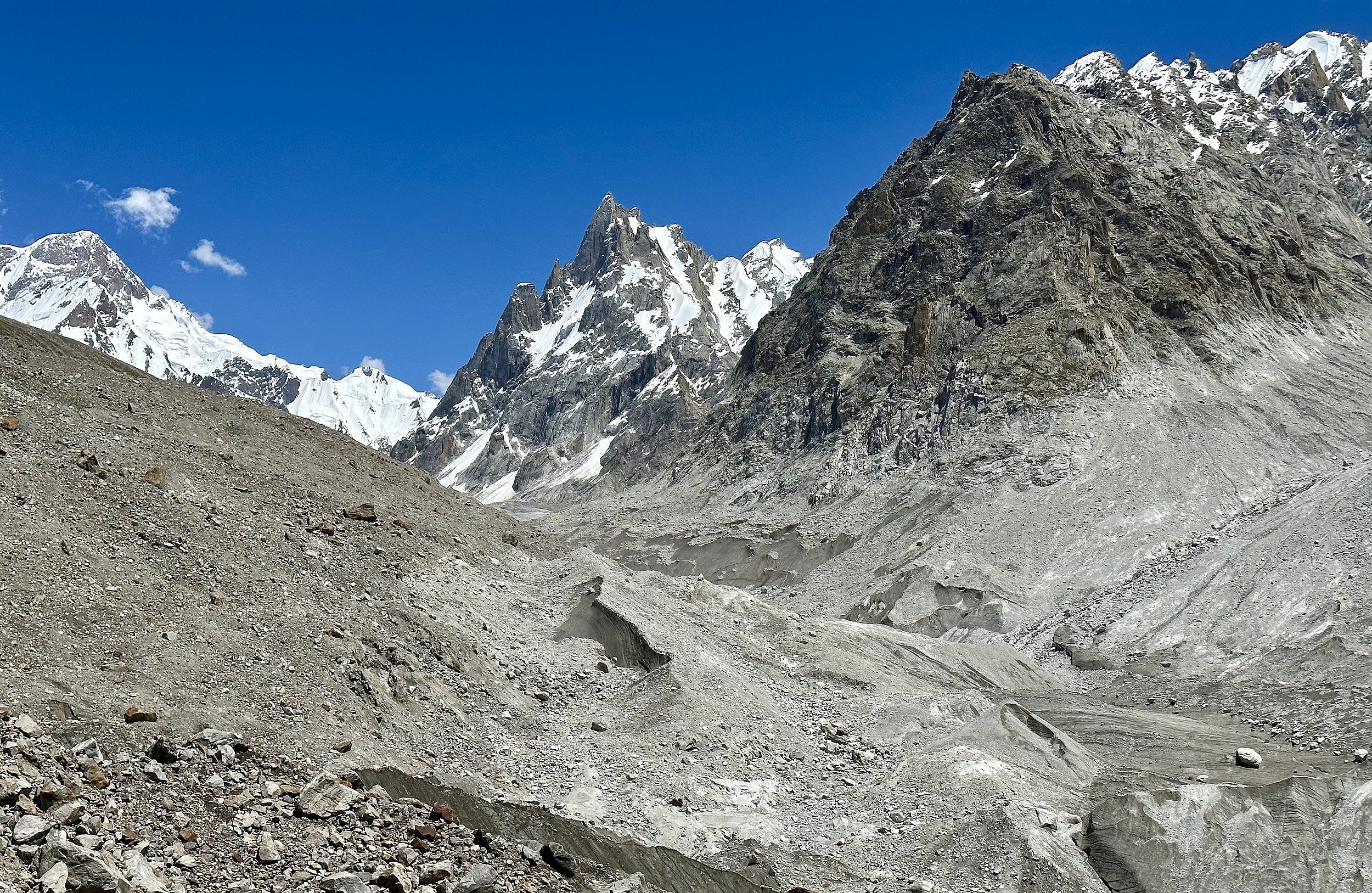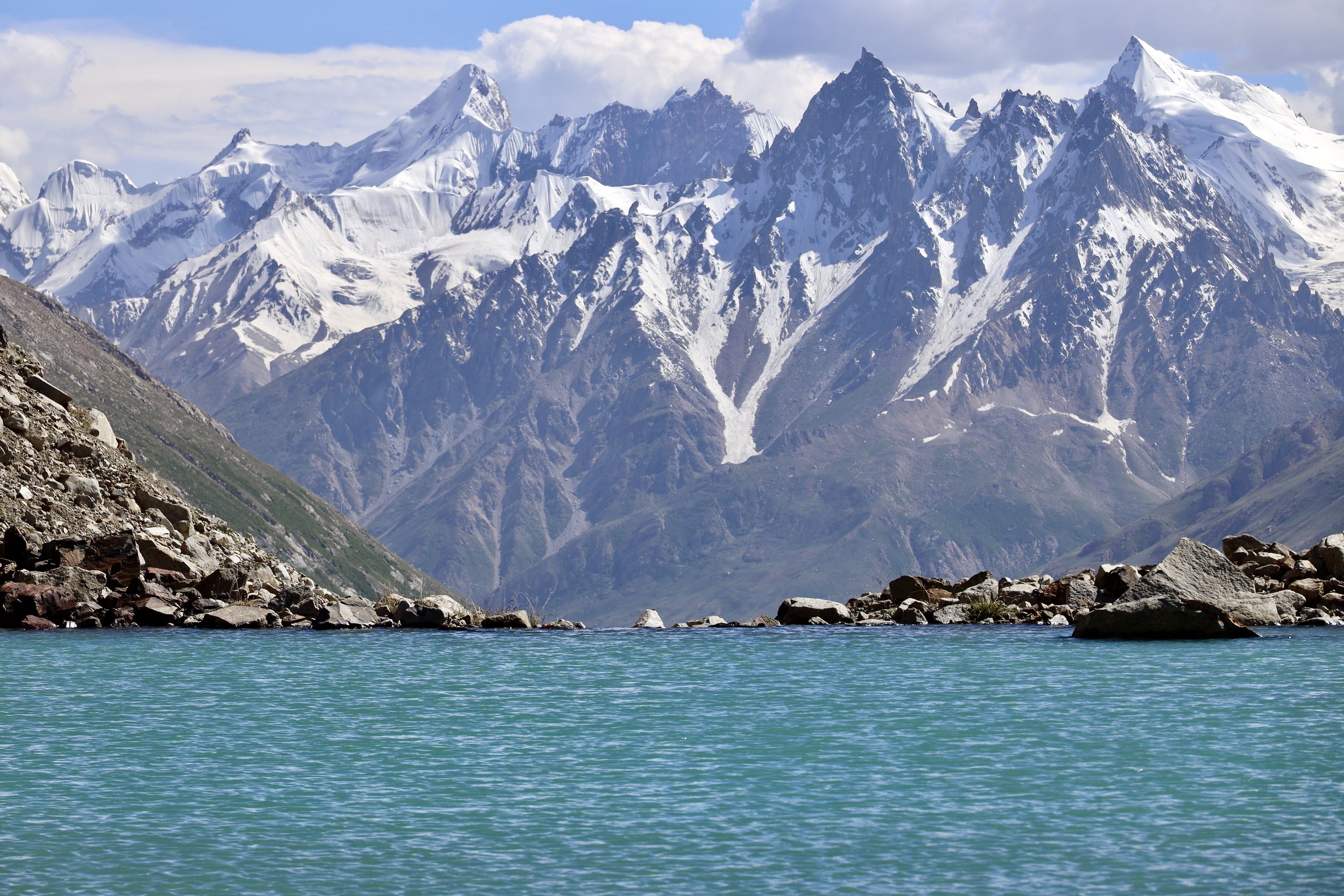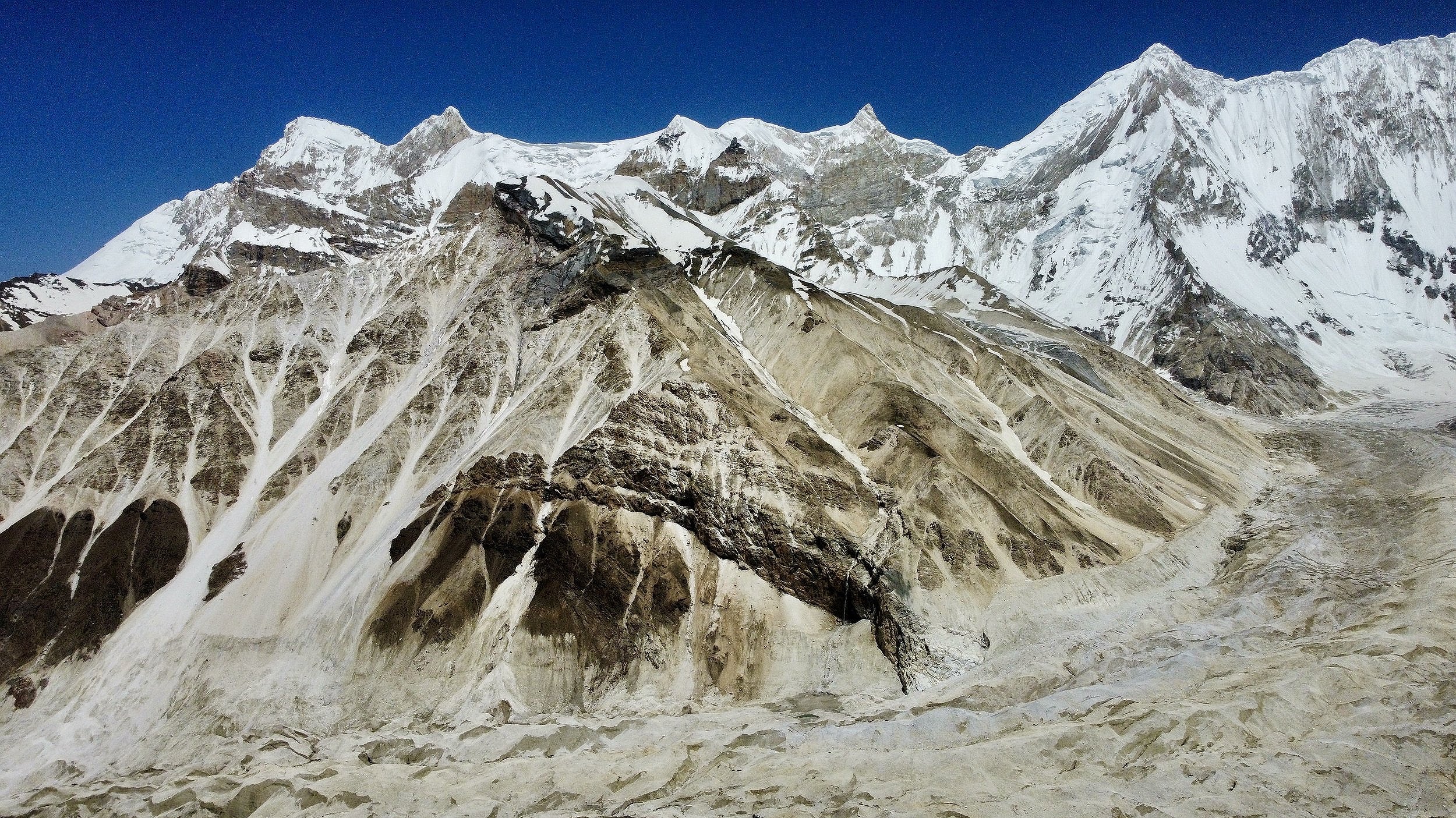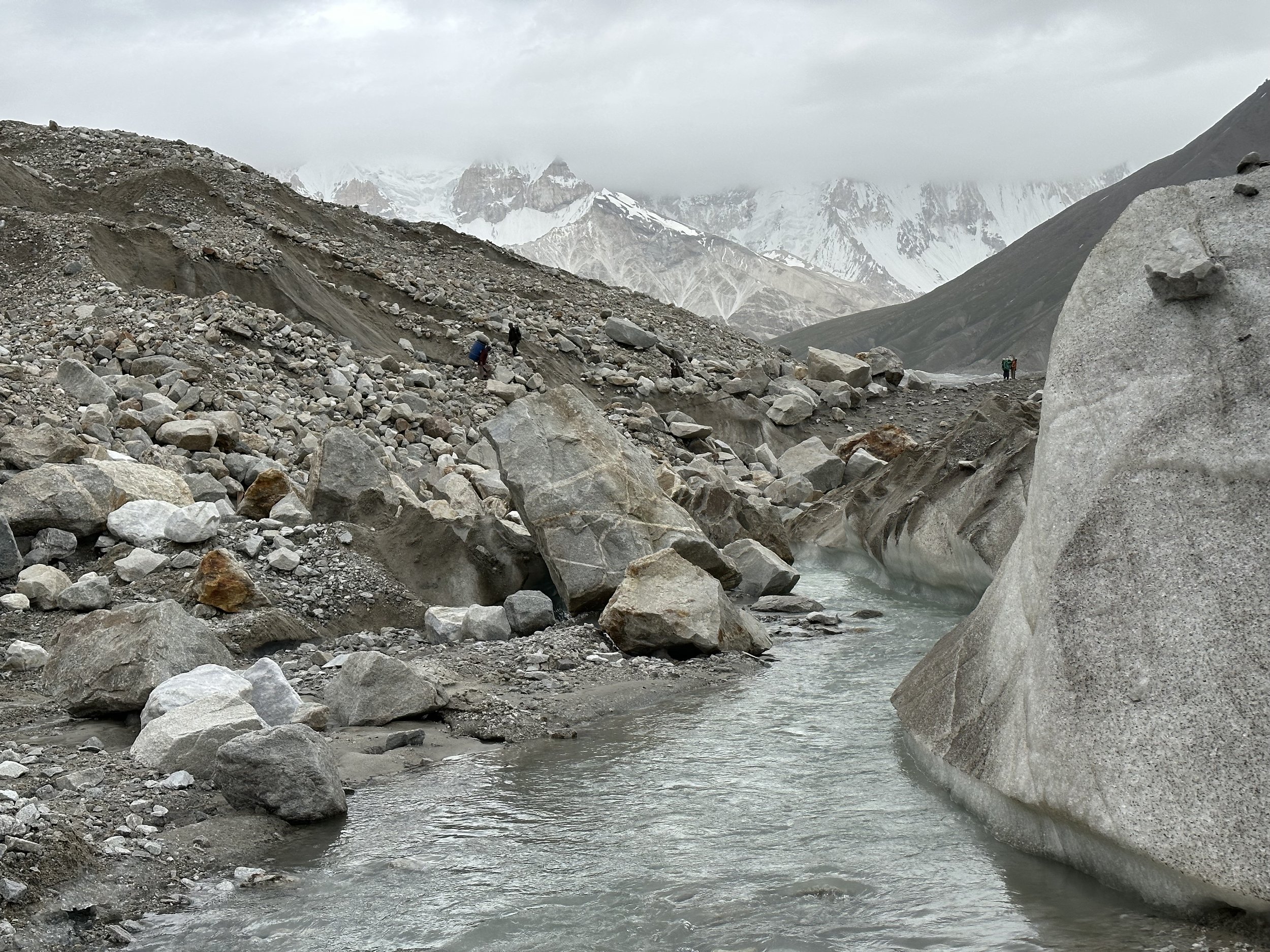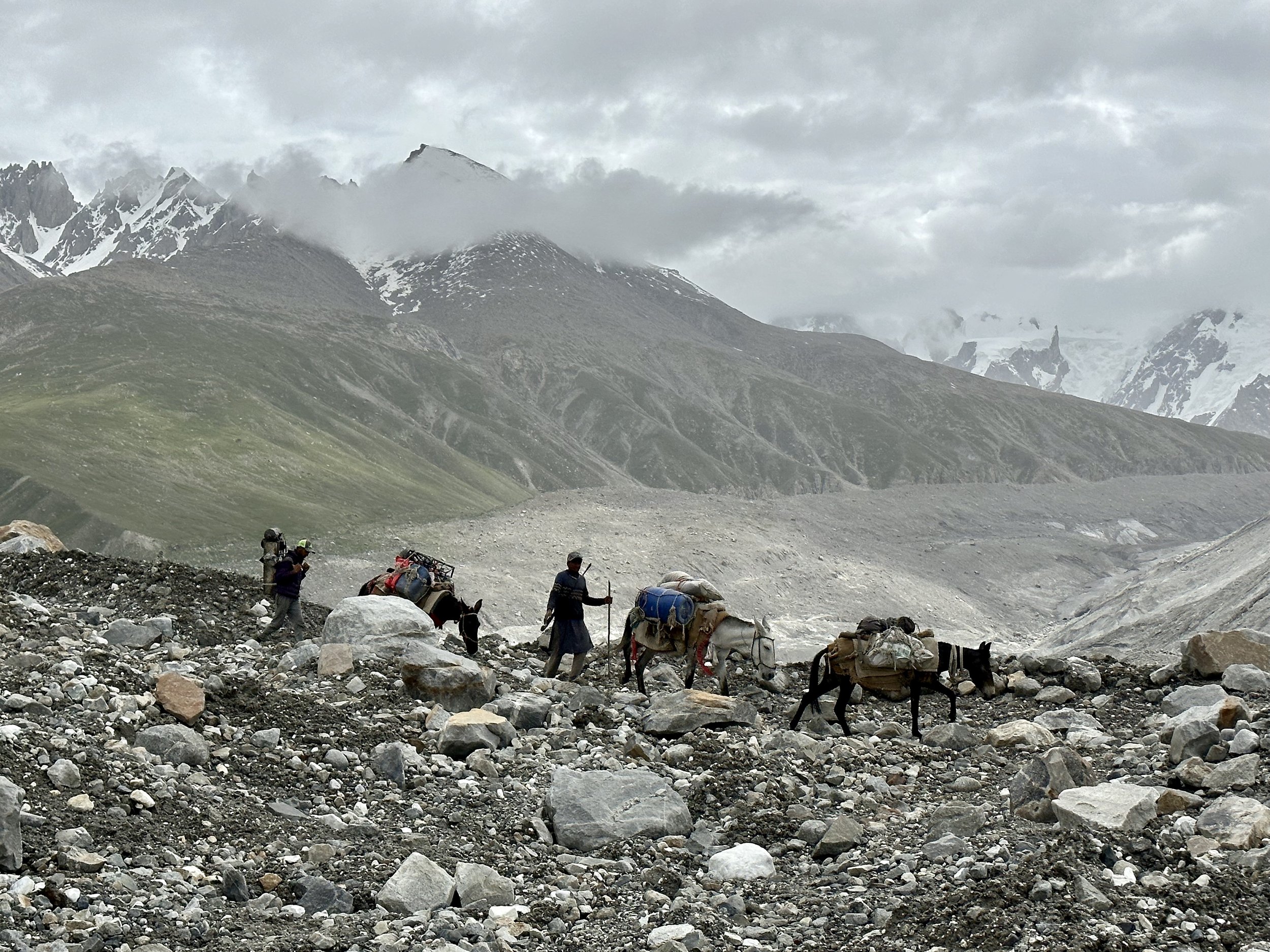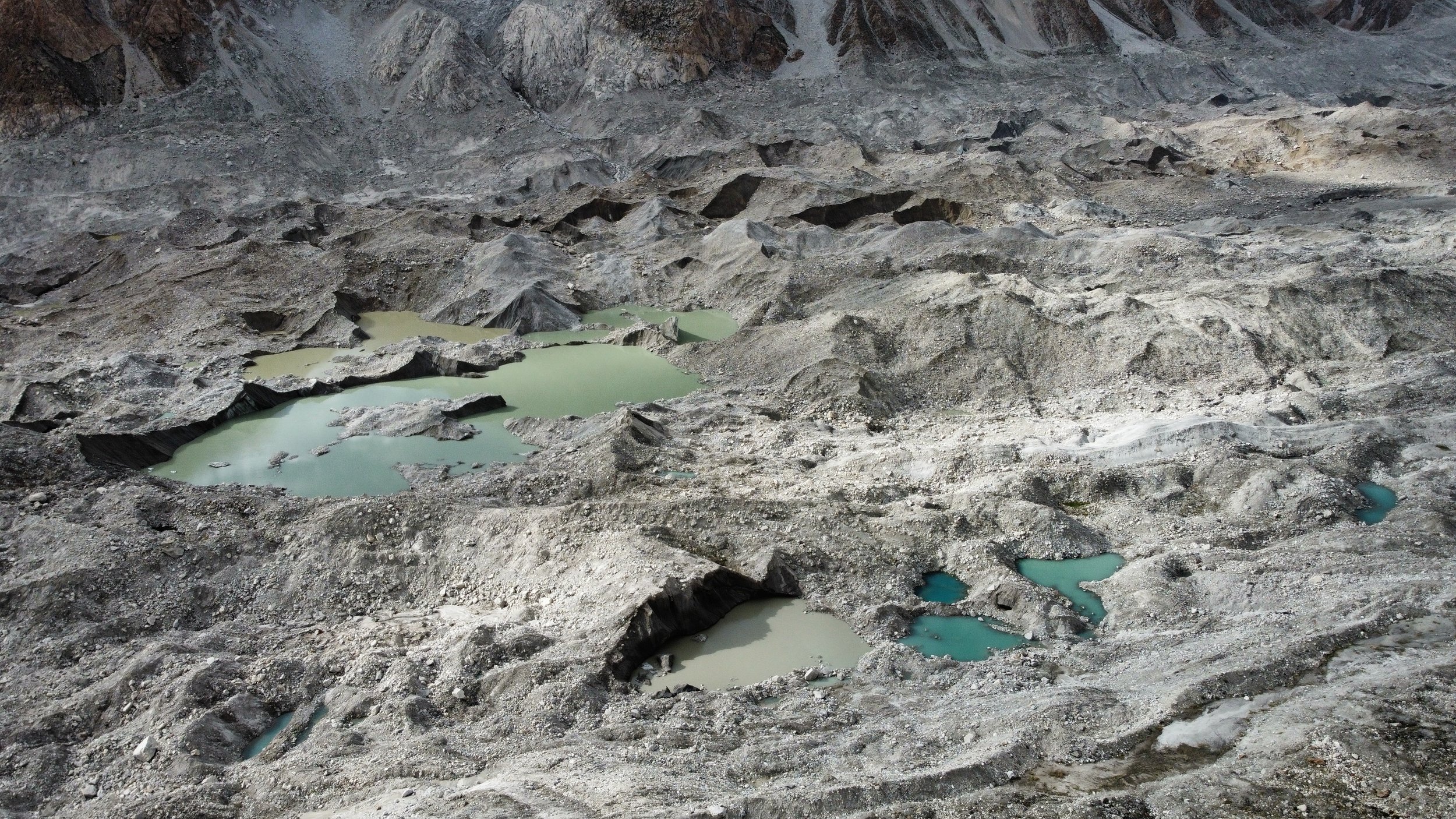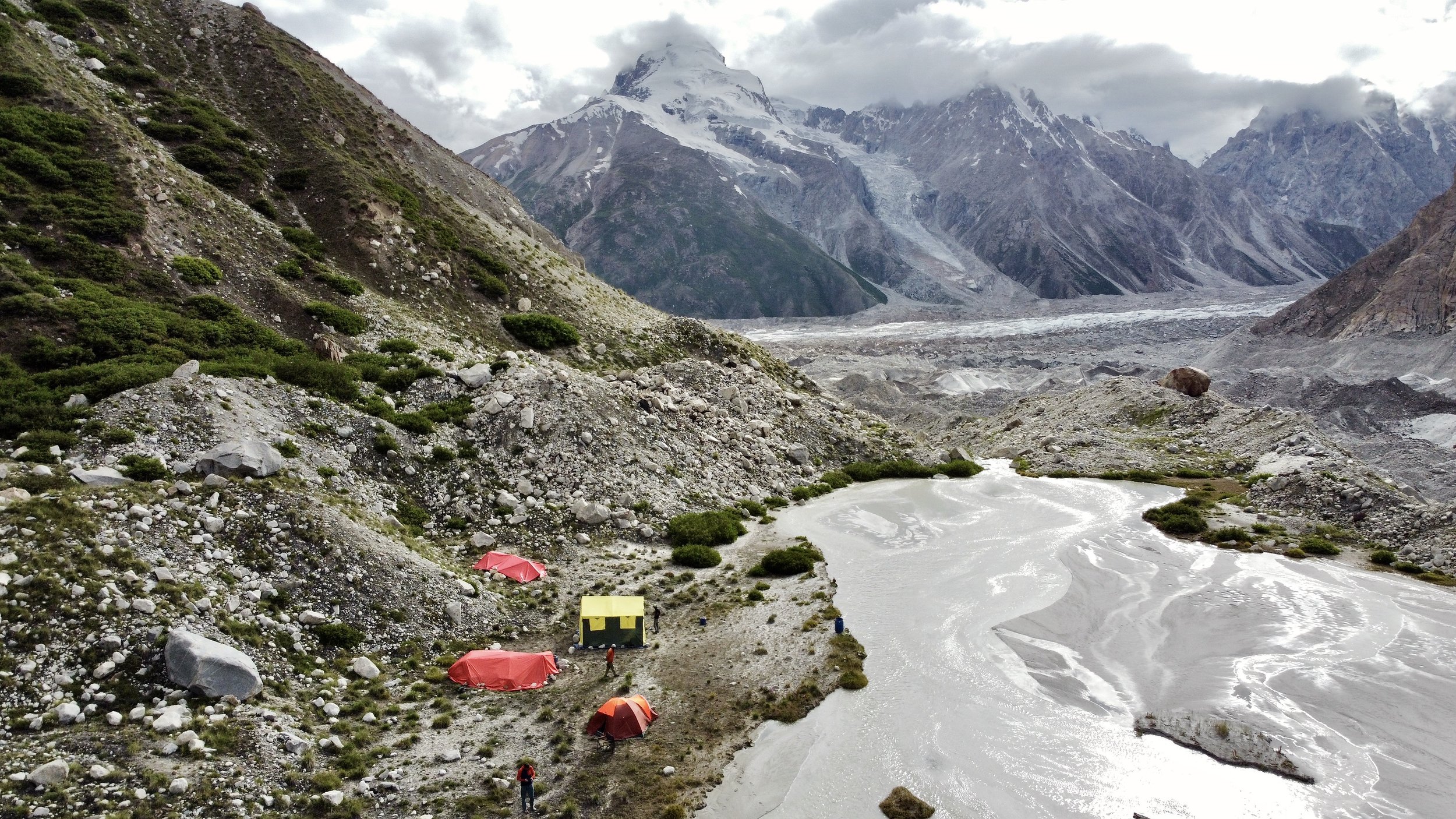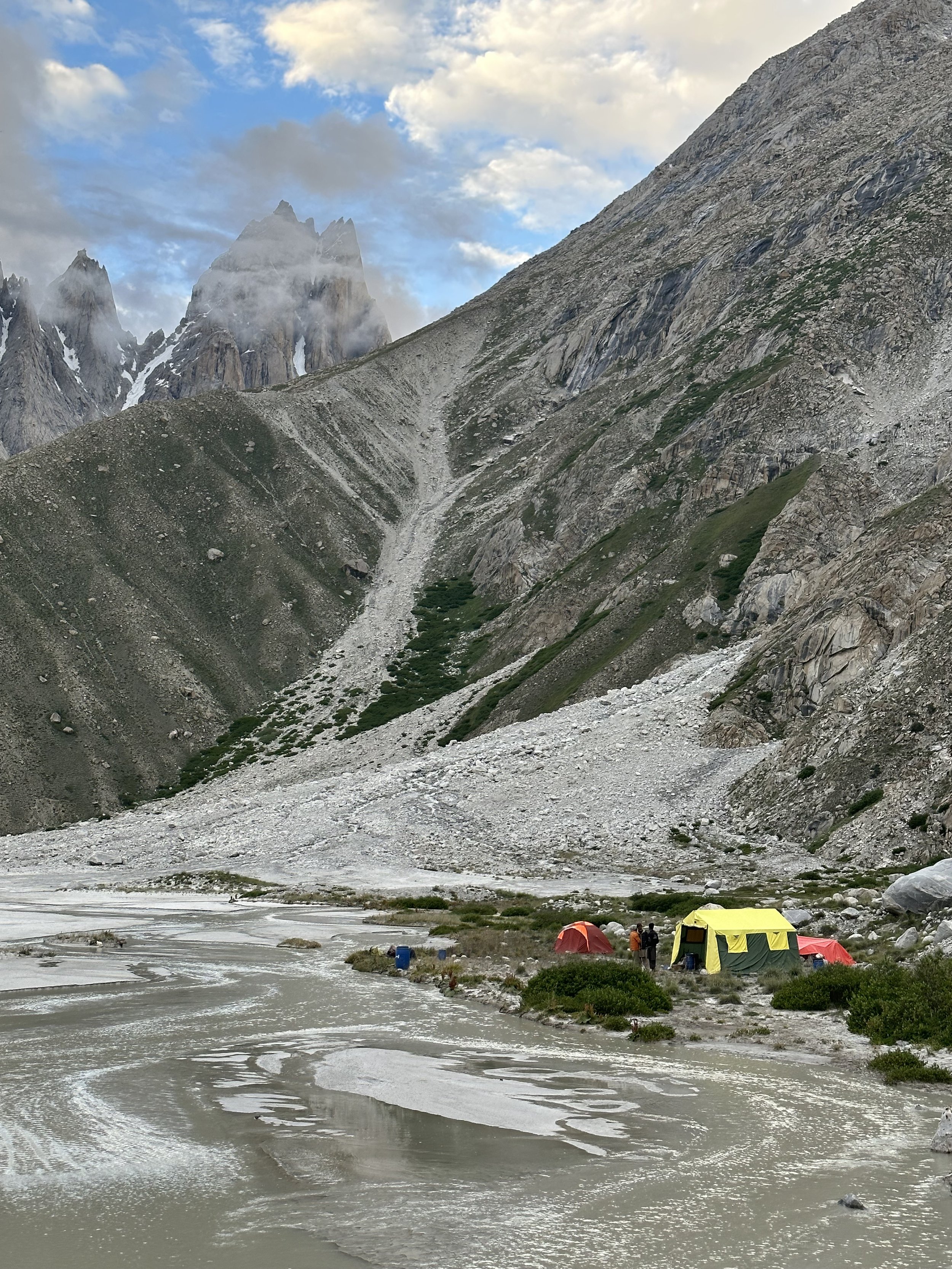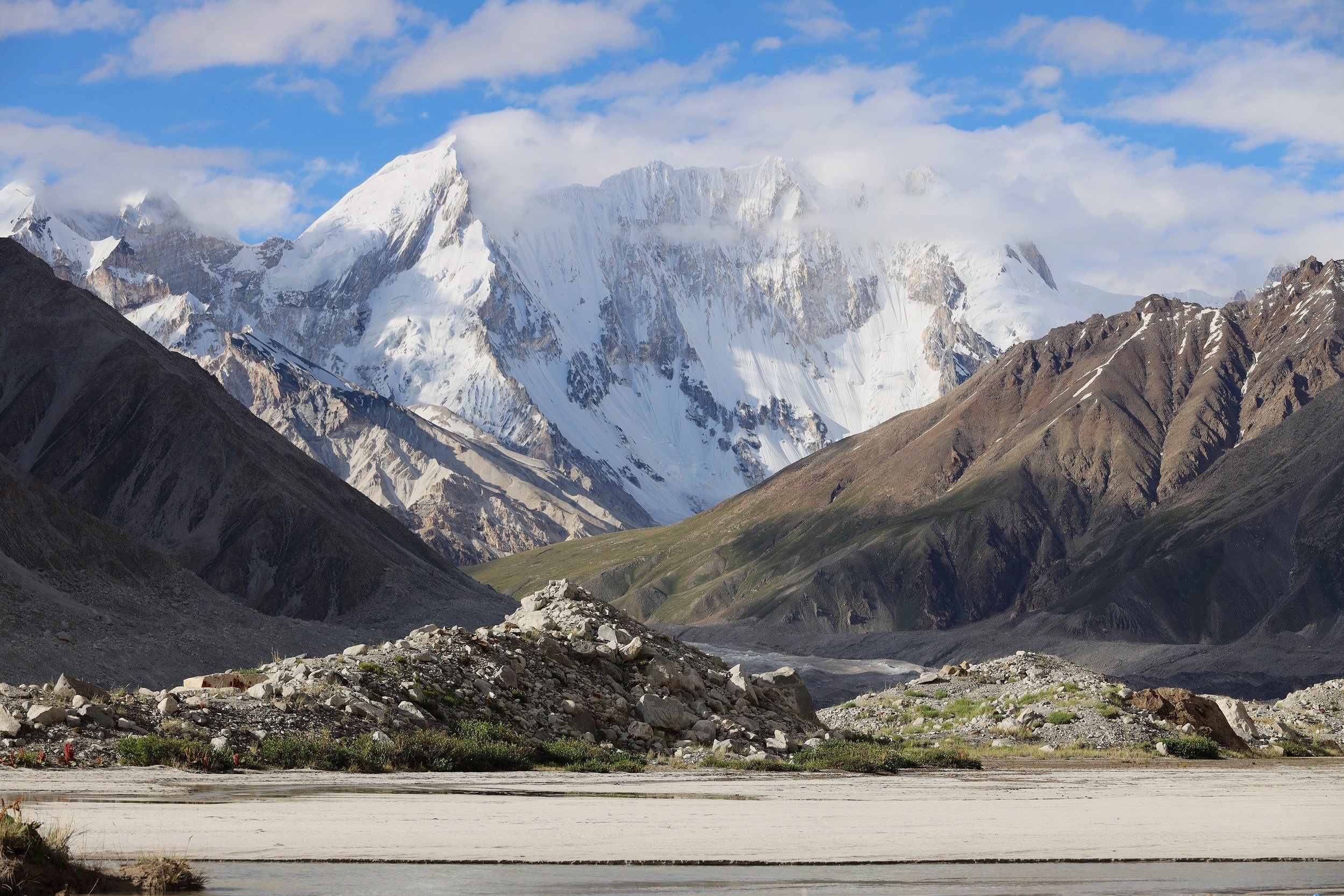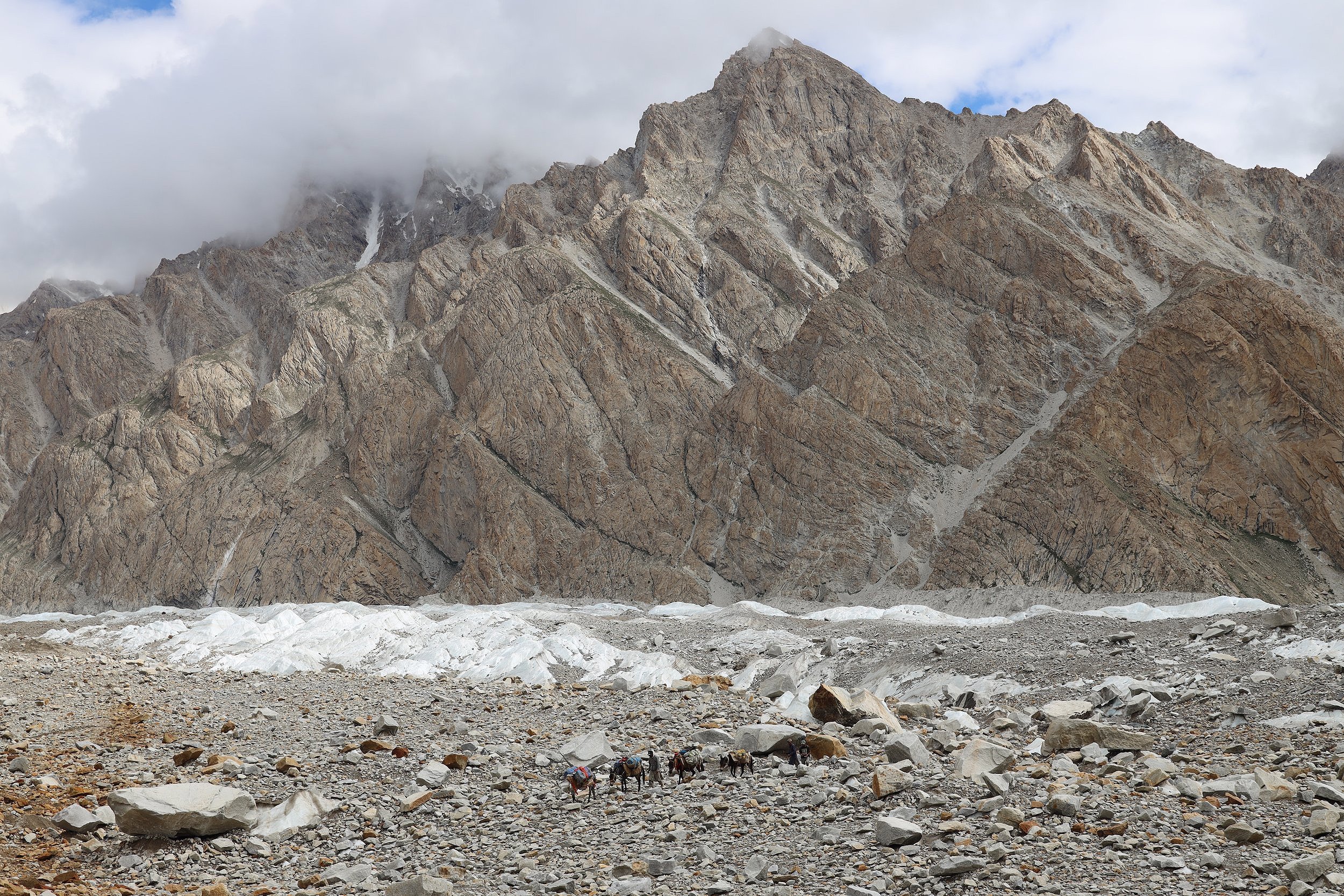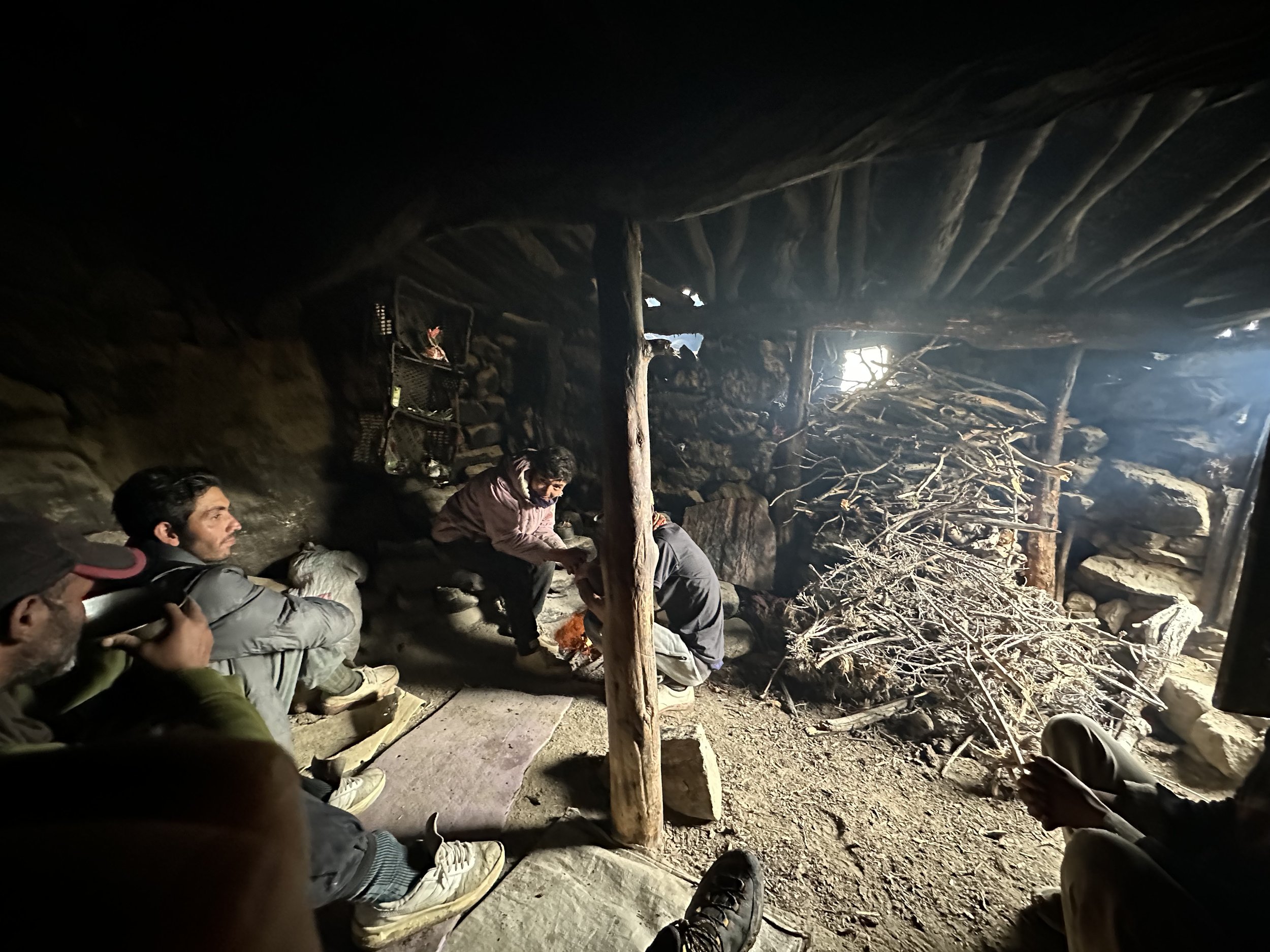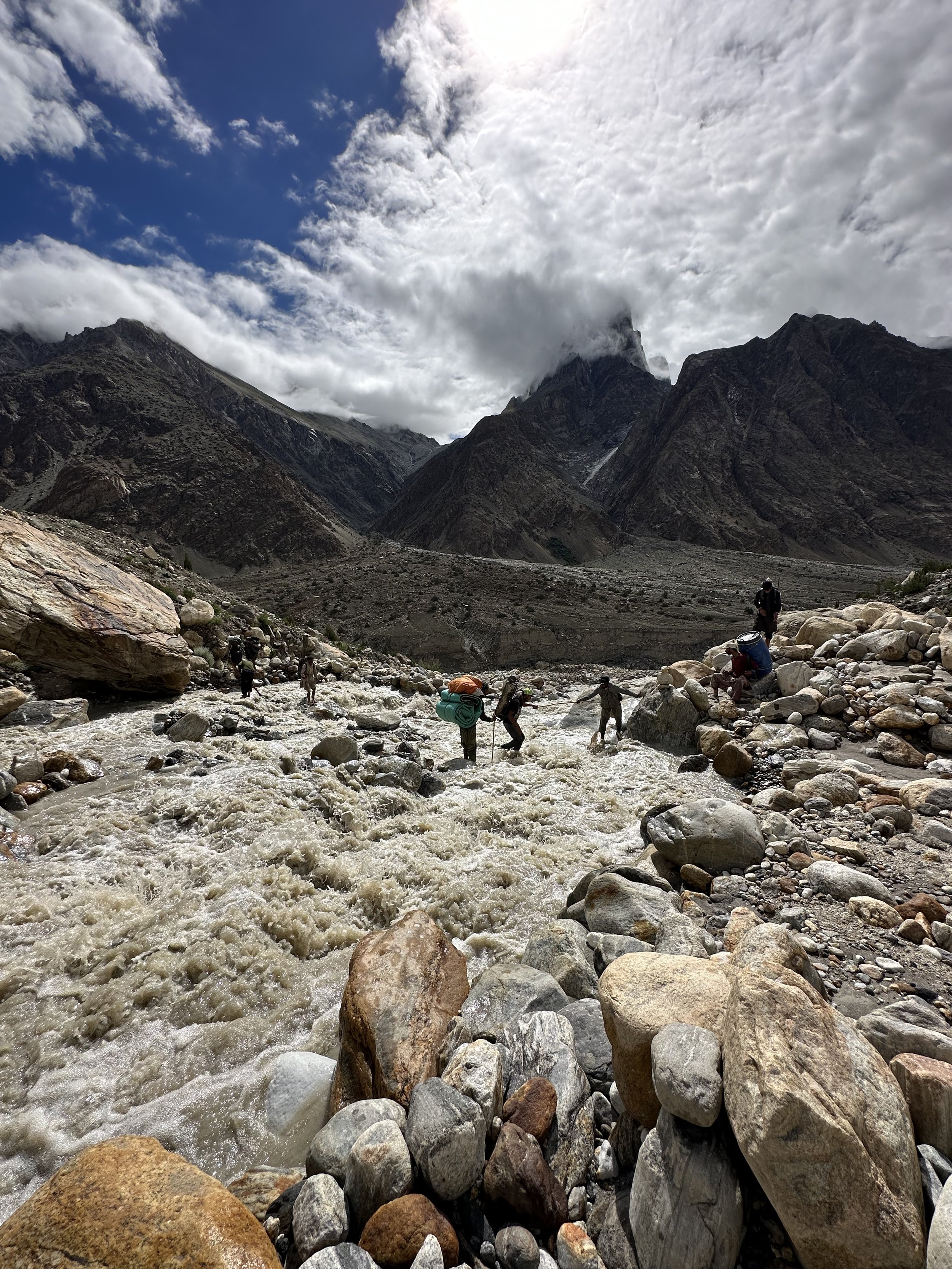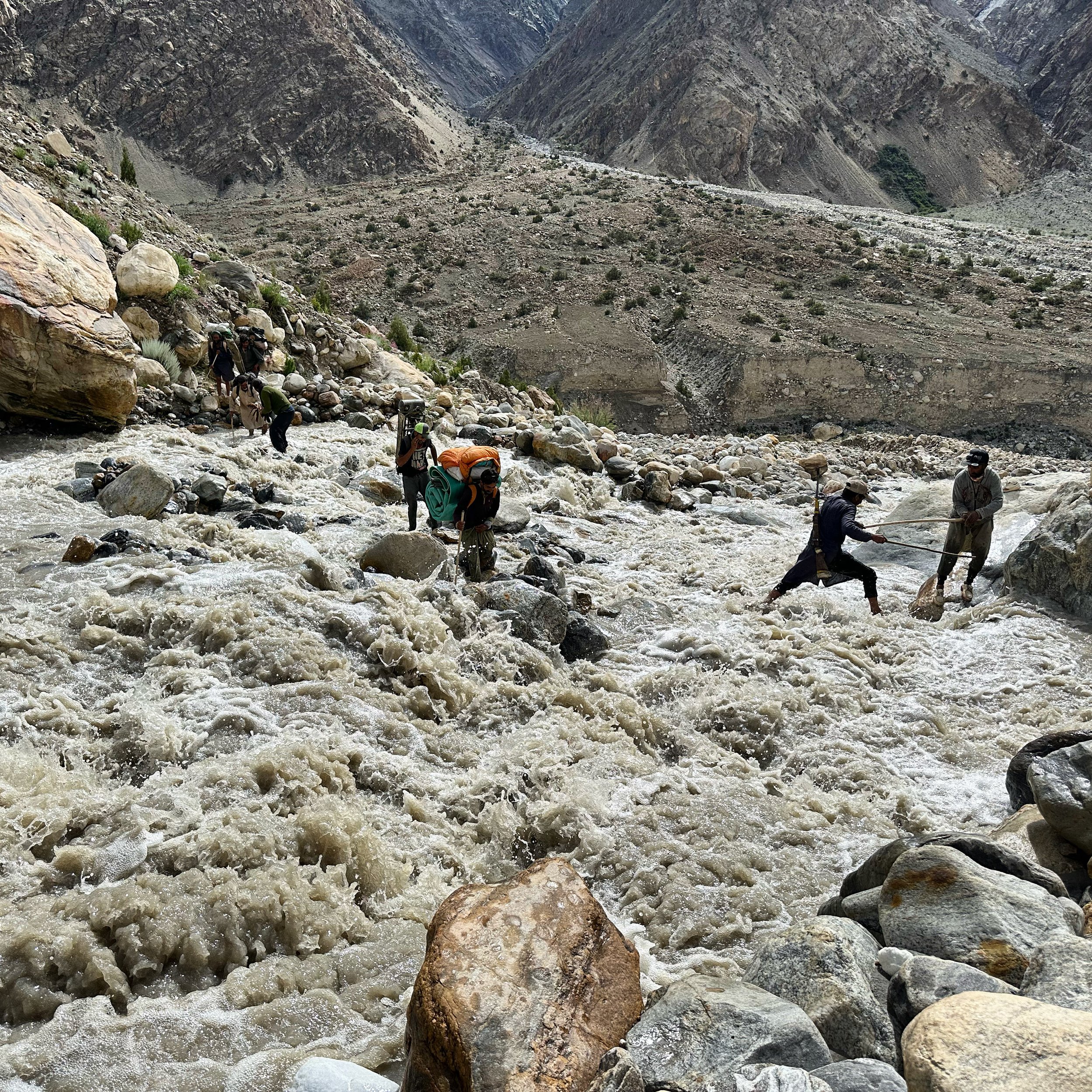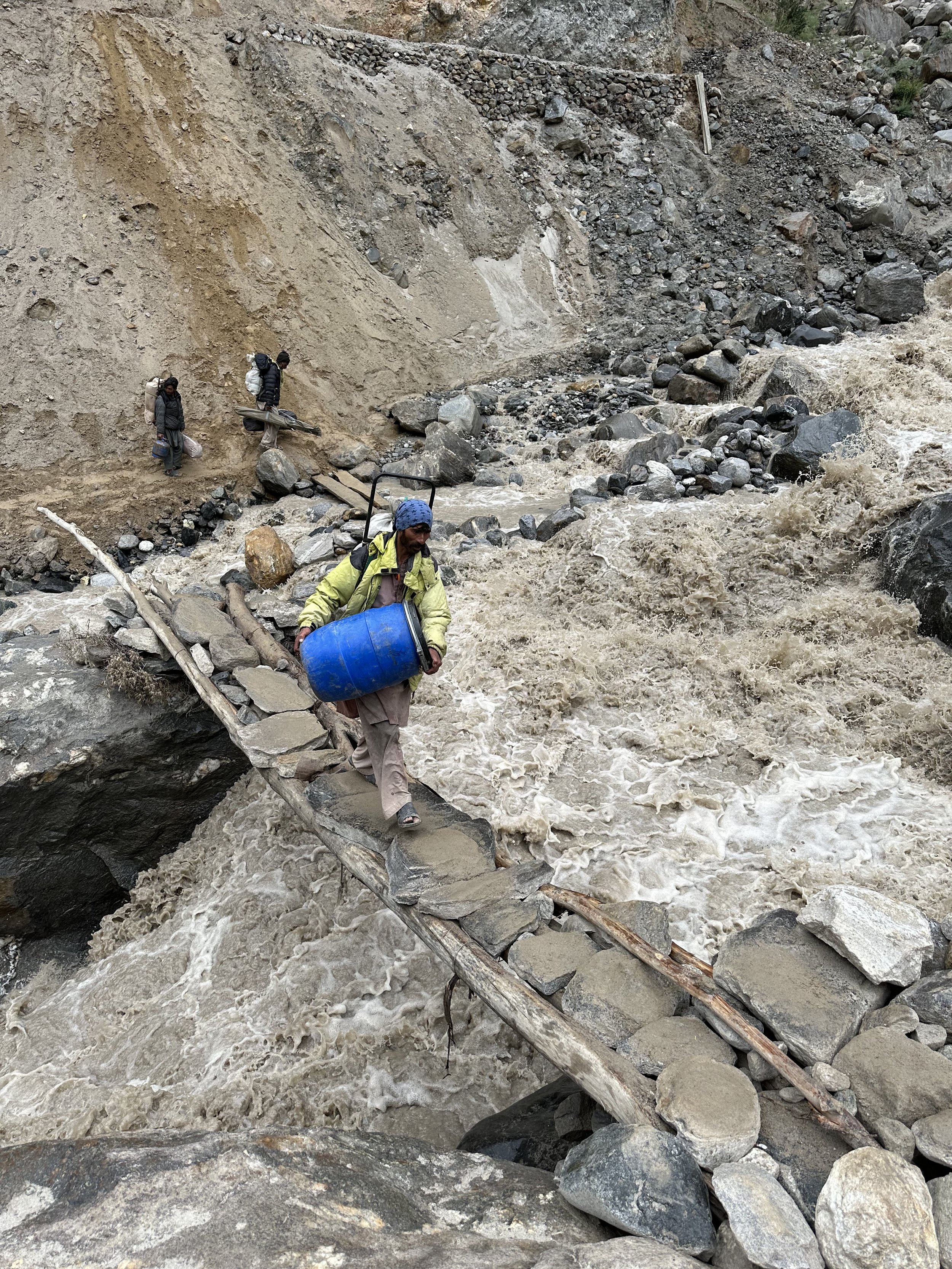This trip was 10 years overdue. I was planning to visit this area of the Karakorum in 2013 but the Nanga Parbat shooting ended my trip before it even started. The main interest of this area is of course, the Choktoi Glacier and the fabulous Latok Peaks. The weather in this corner of the Karakorum is notoriously fickle. This entire conglomerate of glaciers is massive in scale. There are no paths and most of the travel is on glaciers. Thankfully the camps are all in the side valleys. Although there is not a lot of elevation gain per se, i was climbing up and down all day long every day. The biggest challenge is walking on glaciers and trying not to slip on loose rocks that cover the surface. It is not an easy terrain but the views and complete lack of other people make up for it. It is absolutely wild and “undiscovered” corner of the Karakorum Range.
My secondary objective was to gain acclimatization for the Haramosh La crossing at 5,200m. The elevation gain on Haramosh La is very rapid and therefore, good acclimatization is mandatory. I spent 2 weeks over 4000m on this trek so it gave me a good base acclimatization for crossing the Haramosh La.
Thanks to Adventure Karakoram Pakistan and Ghulam from Mountain Travels Pakistan for their assistance, hospitality and great service!
Here is a great documentary that made an impact on me and I remembered it while at the Latok 1 BC:
An overview of the mountains of northern Pakistan. These are not Himalayas but Karakoram, a separate mountain range.
The closeup of the Panamagh, Nobande Sobande and Choktoi glacier system.
We were on the other side of this peak and Skamri Glacier on the China K2 trek in 2016.
An overview of the Chinese side of the Karakorum on the north side of the Baltoro Glacier and Panmagh Glacier.
Biafo, Choktoi and Nobande Sobande Glaciers
The long glacier on the left is Biaffo. Choktoi Glacier runs parallel in the middle/right of the photo. Nobande Sobande is on the far right.
From the book by Thomas Huber “Latok 2016”
Every trip of this sort starts with a mountain of permits and papers!
A mural in Skardu commemorating mountaineers who died in the winder attempt on K2 in 2021.
Skardu and the Indus River
Skardu
Skardu
Indus River near Skardu from the road to Shigar Valley.
Mountains above Askole
Mountains above the snout of the Biafo Glacier. We passed by the Biafo Glacier during the first day of the trek. Biafo Glacier is only 3 hours from Askole, the second last village in the valley.
The bridge over the Biafo River.
Approaching the Biafo Glacier. Benta Brakk (the Ogre) is visible on the horizon.
Biafo River and the snout of the Biafo Glacier
We are heading towards the Jola camp, the first camp of the K2 trek. After the Jola camp, we turned north and have not seen anyone else for two weeks.
Paju Peak spires from the trail to Jola camp.
Looking south from the trail to the Panmagh Glacier.
Mountains near Jola camp
Dumord Vallley. Panmah Glacier ahead.
In the Dumord River valley.
The peaks above the Dumord River Valley
The massive Panmagh Glacier. The glacier is 4 km wide. Skamri Peaks can be seen on the horizon. They form the border between Pakistan and China.
A relatively small side glacier connecting the north side of the Latok group to the Panmagh Glacier. The river flowing out of it was so turbulent that we had to traverse the Panmagh Glacier to bypass it.
Looking back at the small glacier and the satellite peaks of the Latok group from the Panmagh Glacier.
On the Panmagh Glacier.
Negotiating the Panmagh Glacier
Panmagh Glacier
Panmagh Glacier. Skamri Peaks are on the horizon.
Looking across the Panmagh Glacier.
Side moraine of the Panmah Glacier
Approaching our camp at the confluence of the Panmagh and Choktoi glaciers.
Interesting rock towers above the Choktoi Glacier.
Looking over the Panmagh Glacier with Skamri Peaks on the horizon. The Skamri Peaks are 45km away.
Panmagh Glacier and Dumord River Valley
Skamri Peak
Skamri Peak
Our camp on the Choktoi Glacier.
Choktoi Glacier camp.
Choktoi Glacier and our camp. The Latok and Ogre Basecamps are 12 km up the Choktoi Glacier. The Choktoi Peak dominates the view.
The confluence of the Choktoi and Panmagh Glaciers.
The confluence of the Choktoi and Panmagh Glaciers. Our camp is visible below in the centre.
Typical rock formations of the Karakoram range.
On the Choktoi Glacier heading to the Latok bc.
Latok 4 6470m
Latok 4
Latok 4
The lower section of Latok 3
The rock towers at the end of the Choktoi Glacier. The shark fin-like peak is the Biarcheldi Tower.
Latok 3 6915m
Latok 3 6915m
Latok 3 6915m
Choktoi Glacier
Peaks along the Panmagh Glacier. Looking down from the Choktoi Glacier.
Choktoi Glacier
Choktoi Glacier, the tall peak is Baintha Ahrta 6370m
Choktoi Glacier. The peak on the left is Beintha Kabata 6260m.
Beautiful light on the towers at the head of the Choktoi Glacier from the Latok/Ogre bc.
Latok 1 with its summit hiding in the clouds 7145m from Latok/Ogre bc.
The fabulous panorama of the Choktoi Glacier and Latok and Ogre peaks from Latok 1/Ogre bc.
The snowy ridge of Latok 3 6,949m
Ogre 2 and The Ogre
Ogre 2 6885m
Ogre 2 6885m
The Col between Ogre 1 and Ogre 2
Ogre 2 6885m and the Ogre 7270m
Ogre 2 and Ogre 1. The col between the peaks is at 6000m. Its base is 12 km away! The scale of the terrain here is enormous.
Latok 4
Latok 4
The Latok/Ogre bc. In the bc. there was a 4 men European team trying to climb the Ogre 1. After waiting for one month for good weather window, they wrapped up the expedition.
Latok 4 (the highest snow peak on the right) and the Choktoi Glacier
Latok 4 - just shy of 6500m in elevation.
The upper section of the Choktoi Glacier.
Choktoi Glacier and Latok bc (on the curve of the glacier on the right side).
Incredible rock formations of the Latok 4/Latok 2 area.
Choktoi Glacier and the Latok Group.
The challenging terrain of the Choktoi Glacier.
Choktoi Glacier and the Latok 4 cirque.
Choktoi Glacier
Negotiating the jumbled Choktoi Glacier.
Nearing the confluence of the Panmagh and Choktoi Glaciers.
Looking north east from the Choktoi Glacier to the peaks above the Panmagh Glacier.
The confluence of the Choktoi and Panmagh Glaciers. Looking up the Choktoi towards the Latok/Ogre bc.
Latok 4 (left) and Latok 3 (right) . The sharp pointy summit of Latok 1 is visible behind Latok 3.
Latok 4 and Latok 3
Chiring Glacier
Peaks along the Chiring Glacier
Our camp on Panmagh Glacier
Our camp on the Panmagh Glacier at the confluence with the Nobande Sobande Glacier. Skamri Peak dominates the skyline.
Skamri Peaks
Looking south from our camp at the Panmagh Glacier.
Panmagh Glacier - looking south where we came from.
Looking up the Nobande Sobande Glacier towards Snow Lake from 5000m.
Upper Nobande Sobande Glacier
Hanispur 5875m
The incredible views along the Nobande Sobande Glacier
The pointy Choktoi Peak (left)
Choktoi Peak 6150m
Looking south down the Panmagh/Nobande Sobande Glaciers from 5000m.
Rock and snow formations above the Nobande Sobande Glacier.
Skamri Peak forms the border between Pakistan and China.
Skamri Peak and Skamri Glacier.
Upper reach of the Drenmang Glacier which connects to the Nobande Sobande Glacier.
Peaks along the Drenmang Glacier forming the border between Pakistan and China.
Upper reach of the Drenmang Glacier
6000m peaks above the Drenmang Glacier
Skamri
Skamri
On the Panamagh Glacier
The confluence of the Chiring and Panamagh Glaciers.
Panamagh Glacier
Panmagh Glacier
Panmagh Glacier
Our camp called “no wood camp” on the side of the Panamagh Glacier
No Wood camp
No Wood camp
Skamri from the Sandy Camp
Moody light on the Latok peaks and Choktoi Glacier.
Crossing the Choktoi Glacier
Taking a break from the rain in the herders hut for some warm tea and cheer.
After the rains, even small streams that we crossed without any problems on the way in became raging rivers.
Looking back at the Panmagh Glacier.
Small streams turning into raging rivers!
Back In Shigar Valley
Village of Tissar, the home of my crew
Our team: 7 porters, the guide and two horsemen from Askole. The famous “Danger Man” is third from the right! Equally famous Mansoor is the first from the left.
